AbraSilver Resource (TSXV:ABRA) has announced new assay results from the ongoing Phase III drill program at the Diablillos property in Salta Province, Argentina. The results come from four additional diamond drill holes at the company’s 100%-owned property with significant results from the New JAC Zone.
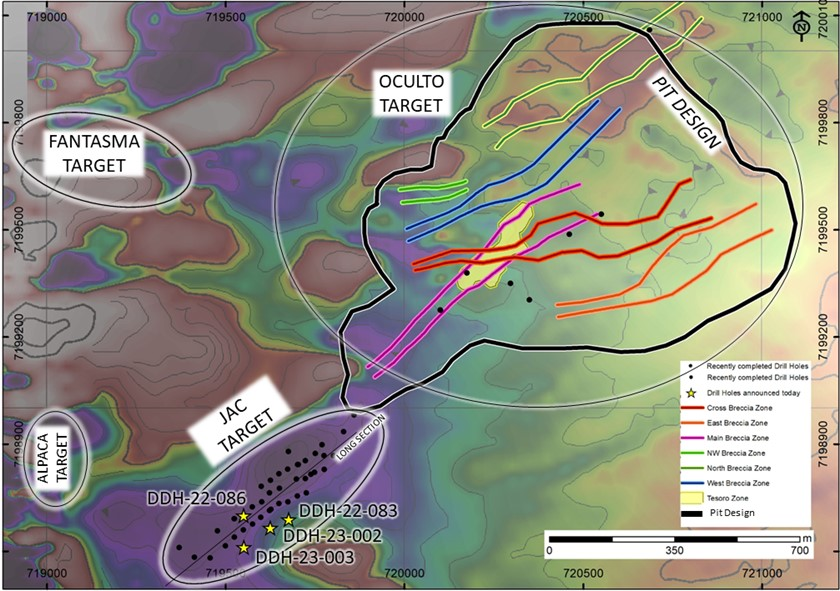
John Miniotis, President and CEO, commented in a press release: “We continue to encounter very impressive drill results, in practically every drill hole, in the new JAC zone. We are also very pleased that the Company remains well-funded to complete the recently expanded drill campaign and deliver on its next set of upcoming milestones including: additional drill results from JAC and other targets, drill results from the La Copita project, an updated Mineral Resource Estimate and a Pre-Feasibility Study at Diablillos before the end of the year. With multiple significant catalysts on the horizon and ongoing exploration drilling, we expect investors will ultimately recognize AbraSilver’s significant value proposition.”
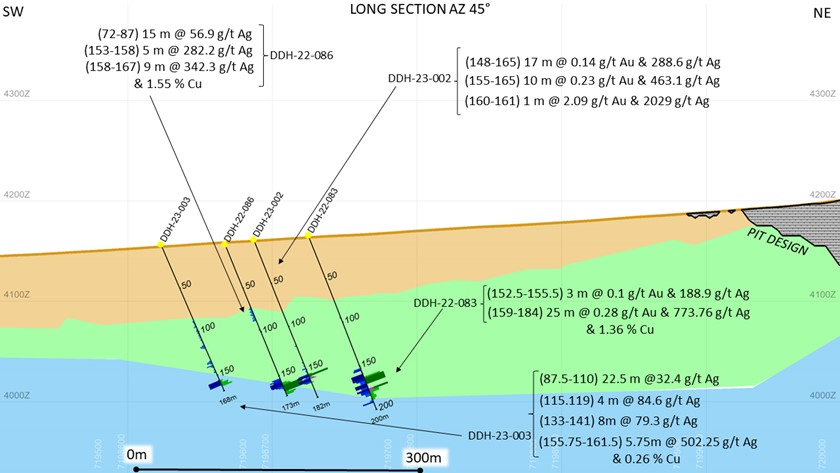
Highlights from the results are as follows:
- DDH 22-083 intersected a broad zone of high-grade silver mineralization in mixed oxides and sulphides, with 25.0 metres at 774 g/t Ag, 0.28 g/t Au and 1.36% Cu starting from a down-hole depth of 159 metres. The interval contained high-grade copper with associated silver mineralization in sulphide bearing feeder structures near the base of the hole.
- DDH 22-086 encountered high-grade silver and copper in sulphides containing 9.0 metres at 342 g/t Ag and 1.55% Cu, directly beneath an oxide zone of 5.0 metres grading 282 g/t Ag
- DDH 23-002 intersected high-grade silver mineralization in an oxide/sulphide transition zone, with 17.0 metres at 289 g/t Ag, including bonanza grades of 2,029 g/t Ag and 2.09 g/t Au over 1.0 metre.
- DDH 23-083 encountered multiple zones of silver mineralization in oxides, and 5.8 meters at 502 g/t Ag and 0.26% Cu in sulphides starting at 156 metres down-hole.
The latest assay result highlights are summarized in Table 1 below.
Table 1 – Diablillos Drill Result Highlights in JAC Zone
(Intercepts greater than 2,000 gram-metres AgEq shown in bold text):
| Drill Hole | From (m) | To (m) | Type | Interval (m) | Ag g/t | Au g/t | Cu % | AgEq1 g/t | |||
| DDH-22-083 | 152.5 | 155.5 | Oxides | 3.0 | 188.9 | 0.11 | – | 197.9 | |||
| DDH-22-083 | 159.0 | 184.0 | Transition | 25.0 | 773.8 | 0.28 | 1.36 | 796.7 | |||
| DDH-22-083 | Includes | 162.5 | 171.0 | Sulphides | 8.5 | 694.7 | 0.10 | 3.36 | 702.9 | ||
| DDH-22-086 | 72.0 | 87.0 | Oxides | 15.0 | 56.9 | – | – | 56.9 | |||
| DDH-22-086 | 153.0 | 158.0 | Oxides | 5.0 | 282.2 | – | – | 282.2 | |||
| DDH-22-086 | 158.0 | 167.0 | Sulphides | 9.0 | 342.3 | – | 1.55 | 342.3 | |||
| DDH-23-002 | 148.0 | 165.0 | Transition | 17.0 | 288.6 | 0.14 | – | 300.1 | |||
| DDH-23-002 | Includes | 155.0 | 165.0 | Transition | 10.0 | 463.1 | 0.23 | – | 481.9 | ||
| DDH-23-002 | Includes | 160.0 | 161.0 | Sulphides | 1.0 | 2,029.0 | 2.09 | – | 2,200.2 | ||
| DDH-23-003 | 87.5 | 110.0 | Oxides | 22.5 | 32.4 | – | – | 32.4 | |||
| DDH-23-003 | 115.0 | 119.0 | Oxides | 4.0 | 84.6 | – | – | 84.6 | |||
| DDH-23-003 | 133.0 | 141.0 | Oxides | 8.0 | 79.3 | – | – | 79.3 | |||
| DDH-23-003 | 155.8 | 161.5 | Sulphides | 5.8 | 502.2 | – | 0.26 | 502.2 | |||
Note: All results in this news release are rounded. Assays are uncut and undiluted. Widths are drilled widths, not true widths. True widths are estimated to be approximately 80% of the interval widths.
1AgEq based on 81.9(Ag):1(Au) calculated using long-term prices of US$25.00/oz Ag and US$1,750/oz Au, and 73.5% process recovery for Ag, and 86.0% process recovery for Au as demonstrated in the Company’s Preliminary Economic Assessment in respect of Diablillos dated January 13, 2022, using formula: AgEq g/t = Ag g/t + Au g/t x (Gold Price/Silver Price) x (Gold Recovery/Silver Recovery). No value is ascribed to copper grades in the AgEq calculations.
Exploration Update
Drilling activity at Diablillos remains focused on the recently discovered JAC zone which is located several hundred metres southwest of the conceptual open pit that constrains the current Mineral Resource estimate (“MRE”) on the main Oculto deposit (M&I MRE containing 1.3 Moz gold and 109 Moz silver – Table 2).
To date, the Company has completed approximately 12,900 metres of drilling, in 65 holes, as part of the 22,000-metre Phase III program. Drilling results to date, combined with interpretation of magnetics, suggest that the new JAC zone remains open in multiple directions.
At the La Copita project, drilling is progressing with the hole currently at a down-hole depth of approximately 130 metres. The deep hole is targeting the anticipated higher-grade zone of the porphyry system intercepted in hole DDHC 22-002.
Collar Data
| Hole Number | UTM Coordinates | Elevation | Azimuth | Dip | Depth (m) | |
| DDH 22-083 | E719676 | N7198689 | 4,165 | 0 | -60 | 200 |
| DDH 22-086 | E719550 | N7198700 | 4,156 | 0 | -60 | 173 |
| DDH 23-002 | E719625 | N7198665 | 4,161 | 0 | -60 | 182 |
| DDH 23-003 | E719551 | N7198611 | 4,156 | 0 | -60 | 168 |
The above references an opinion and is for information purposes only. It is not intended to be investment advice. Seek a licensed professional for investment advice. The author is not an insider or shareholder of any of the companies mentioned above.

The above references an opinion and is for information purposes only. It is not intended to be investment advice. Seek a licensed professional for investment advice. The author is not an insider or shareholder of any of the companies mentioned above.
Marimaca Copper (TSX:MARI) has announced assay results for gold and silver from drill hole MAD-22 at the Marimaca Copper project. The results outlined the first phase of follow-up drilling of the exciting new sulphide target identified in drill hold MAD-22, originally intersecting 120m at 1.7% CuT including 92m at 2.11% CuT. These results are the first anomalous precious metal content encountered at the Marimaca Project.
The Marimaca project is located in the Antofagasta region of northern Chile, a well-known copper mining district. Marimaca Copper. holds a 100% interest in the project. The recent drilling at the Marimaca project has been focused on exploring the potential for new sulfide mineralization. Sulfide deposits are typically higher grade than oxide deposits and can be economically attractive for mining. The discovery of a new sulfide target in MAD-22 was a significant development, and the follow-up drilling was designed to better understand the nature of this mineralization.
The assays from MAD-22 have shown that the sulfide mineralization is associated with significant gold and silver mineralization. This is the first time that anomalous precious metal content has been encountered at the Marimaca project. The results from MAD-22 also show that the gold and silver mineralization is associated with the deeper sulfide mineralization, which is consistent with other sulfide deposits in the region.
The results from MAD-22 are encouraging for Marimaca Copper Corp. and demonstrate the potential for the discovery of additional high-grade sulfide mineralization at the Marimaca project. The company plans to continue drilling to further explore the sulfide target identified in MAD-22 and to test other targets in the project area.
In addition to the sulfide targets, Marimaca Copper Corp. is also continuing to explore the oxide mineralization at the Marimaca project.
Sergio Rivera, VP Exploration of Marimaca Copper, commented in a press release: “MAD-22 was a spectacular drill hole in terms of grade, continuity and the shallow nature of mineralization, and provided us with valuable information with respect to potential sulphide feeder zones for the Project. As we have noted in previous releases, there is a strong correlation between magnetic anomalism and the presence of primary copper mineralization. MAD-22 once again strongly confirmed the relationship. It has also been noted that outcropping zones with higher prevalence of magnetite, in veins and stringers, could be a good surface vector for future exploration targeting Marimaca-style IOCG (Iron Oxide Copper Gold) deposits.
“In 2020, we completed high resolution magnetic work and developed a 3D model which highlights a large-scale magnetic anomaly, which we estimate to be over 175 million 3 meters in volume, or approximately 475 million 2 tonnes of high magnetic susceptibility rock mass. MAD-22 was drilled into the southern extent of this anomaly, which extends over strike of approximately 1.0km and to a depth of around 800m below surface.
“The result of MAD-22 is an exciting confirmation of our view that there is significant sulphide potential below the MOD. We have mobilized a rig to complete an initial follow up program to test the immediate 300m to 500m of strike around MAD-22. Based on the results we achieve we will then plan an expanded programme.”
Highlights from the results are as follows:
Table 1. Summary of Anomalous Precious Metal Intervals

Table 2. Drill Collars and Survey

- First anomalous gold and silver identified at Marimaca coincident with higher grades of primary copper mineralization in MAD-22
- 100m of anomalous gold (majority >0.02g/t) and silver (majority >1g/t) from 140m
- 40m with an average grade of 3.74% CuT and 0.07g/t Au and 7g/t Ag from 186m
- Represents 40m with an average grade of 3.84% CuEq 1 from 186m
- MAD-22 intersected over 240m of continuous mineralization from surface with a high grade primary mineral zone at depth including:
- Reconfirms strong association of high-grade chalcopyrite with high magnetic susceptibility
- Encountered massive chalcopyrite over an interval of 92m with an average copper grade of 2.11% CuT from 140m
- Located immediately adjacent to the eastern wall of the whittle pit limits for the October 2022 MRE, indicating potential for high grade, open pit-able mineralization
- Indications are that mineralization relates to a second, later stage, mineralizing event when compared to the broader
Marimaca Oxide Project
- Large scale magnetic anomaly previously identified believed to be prospective for mineralization similar to the primary
zone in MAD-22 - Five-hole diamond drilling program planned, and rig mobilised, to follow up results of MAD-22:
- 50m to 100m step outs from MAD-22
- First phase tests approximately 300m of strike potential around MAD-22 with a target width of up to 300m
- Drilling will test deeper extensions below the limit of drill hole MAD-22, which terminated in mineralization
- Second phase of up to five holes based on results of first phase increase tested strike length to 500m+
- Fully funded to test the exciting sulphide target





Figure 5: Relationship of Magnetic Susceptibility and Drilling Across the Project. Source: Marimaca Copper
The above references an opinion and is for information purposes only. It is not intended to be investment advice. Seek a licensed professional for investment advice. The author is not an insider or shareholder of any of the companies mentioned above.
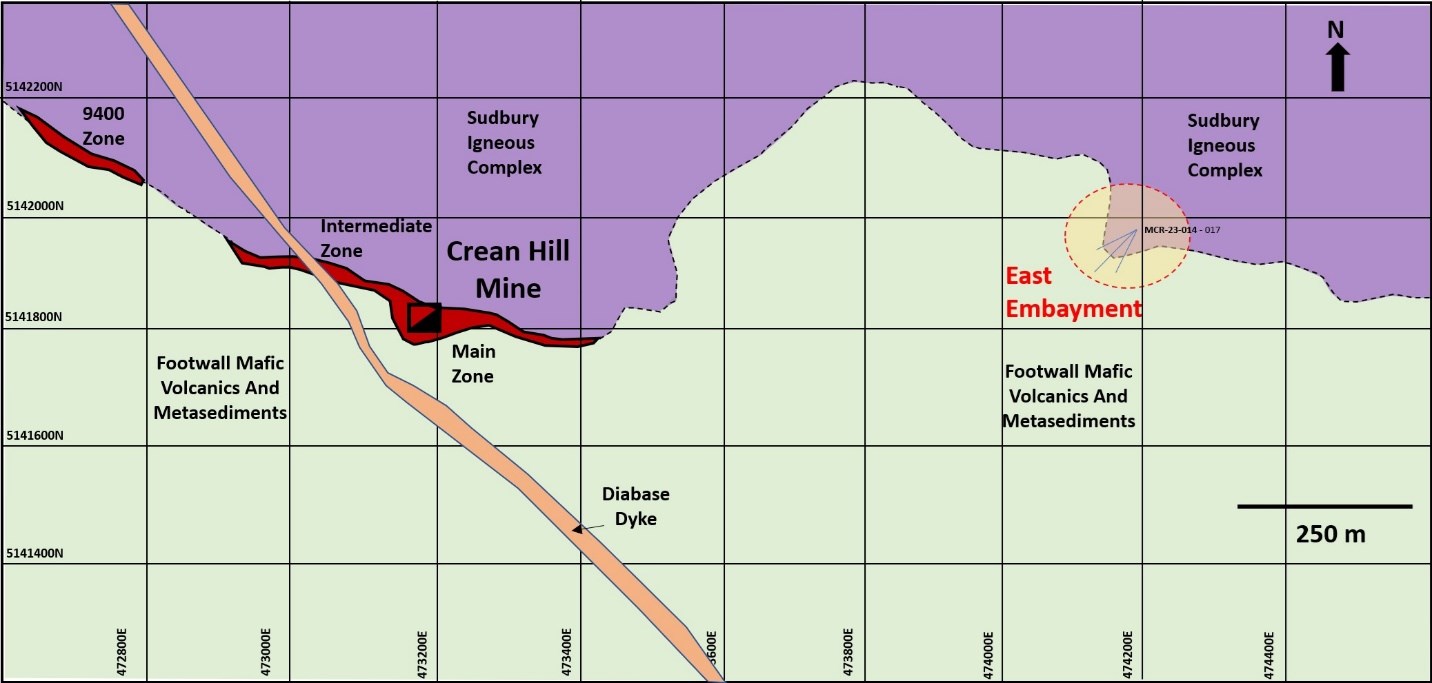
Magna Mining (TSXV:NICU) has announced that ongoing drilling confirmed a new zone of near surface sulphide mineralization located roughly 1000 metres east of Crean Hill Main Zone. The company has completed four holes, intersected disseminated to local semi-massive sulphides within a narrow embayment structure at the Sudbury Igneous Complex.
The most recent drilling targeted near the historical drill hole LM01800, which intersected 0.58% Cu, 0.72% Ni over 33.2 metres and 0.39% Cu, 0.67% Ni over 20.2 metres starting at 10.3 metres downhole.
The historical drill hole was drilled beneath a mineralized outcrop at surface. Before this, it had not followed up with drilling. Magna Mining also intersected between 25 and 60 metres of disseminated sulphides, including narrow semi-massive intervals of less than 1 metre at drill holes MCR-23-014 to MCR-22-17.

Dave King, SVP of Magna, commented in a press release: “We are encouraged to intersect near surface mineralization along strike of the known Crean Hill mine ore zones. The widths of mineralization intersected are significant, and if the copper and nickel grades are consistent with the historical drill hole, LM01800, with further definition drilling this zone may potentially be amenable to open pit mining. We expect to have assay results for this initial drilling within four weeks and will report results soon after they are received.”
Mynyr Hoxha, Vice President Exploration, commented: “We are very pleased to report that this diamond drill program was successful in identifying a wide zone of mineralization between the existing resource and surface in the West Zone, in an area previously interpreted as waste in the 2022 feasibility study. Results from the additional 2022 exploration drilling have also demonstrated that the West Zone remains open for expansion along strike to the west and down-dip to the south, where the dip of the mineralization is shallower than previously interpreted. Having intersected this zone of shallow-dipping mineralization cutting through the gabbros in multiple holes now, we believe this could be the feeder system for the entire mineralized Shakespeare deposit.”
Highlights from the results are as follows:
SHAKESPEARE ASSAY RESULTS
Magna Mining is also pleased to report that assay results from the second phase of 2022 drilling at the Shakespeare deposit have now been received. A total of 1,902 metres of drilling across nine drill holes was completed in this phase of the 2022 drill program, the results of which are summarized below. Drill hole locations are shown in Figures 3 and 4, and assay results are summarized in Table 1. A summary of the pertinent conclusions from these results is as follows:
- Drilling has successfully expanded the West Zone mineralization both down-plunge, and closer to the surface in areas which were previously undrilled. The West Zone remains open along the strike and down-dip to the south. The results confirm the potential to add near surface resources around the West Zone.
- Further successful drilling in the area between the East and West zones (MMC-22-47) supports the hypothesis that the Shakespeare open pit could be optimized in the future through incorporating East and West Zone mineralization into a single open pit design.
- Mineralized intercepts are consistent with grades and tenors that are reported in the existing NI 43-101 compliant mineral resource and reserve estimates for Shakespeare.
Highlights of the Shakespeare 2022 Phase 2 drilling include:
- MJU-22-01 intersected 0.25% Ni, 0.32% Cu, 0.81 g/t Pt + Pd + Au over 36.1m. This hole was targeting a near surface area of the West Zone, which was within the feasibility study pit shell, but previously undrilled and interpreted as waste rock.
- MMC-22-45 intersected 0.30% Ni, 0.58% Cu, 1.04 g/t Pt + Pd + Au over 16.6m, extending known mineralization in the West Zone near the “S-13 Zone”, and extends the newly identified shallow dip of mineralization further to the south.
- MMC-22-47 intersected 0.34% Ni, 0.40% Cu, 1.01 g/t Pt + Pd + Au over 11.2m in an area below historical drilling and demonstrates continuity of the mineralization in this brecciated area. This area of mineralisation remains open to west.
- MMC-22-48, intersected 0.23% Ni, 0.28% Cu, 0.80 g/t Pt + Pd + Au over 34.0m down-plunge of the current West Zone resource, further extending the known depth extent of mineralization in the West Zone.
A total of 4,020m of drilling across 15 drill holes was completed at Shakespeare in 2022. The 2022 exploration program has been successful in testing and expanding the West Zone mineralization, refining the geological model, and identifying new exploration targets that could represent areas for further expansion of the Shakespeare Deposit. The 2023 exploration and drilling program at Shakespeare is scheduled to commence in Q2 2023.
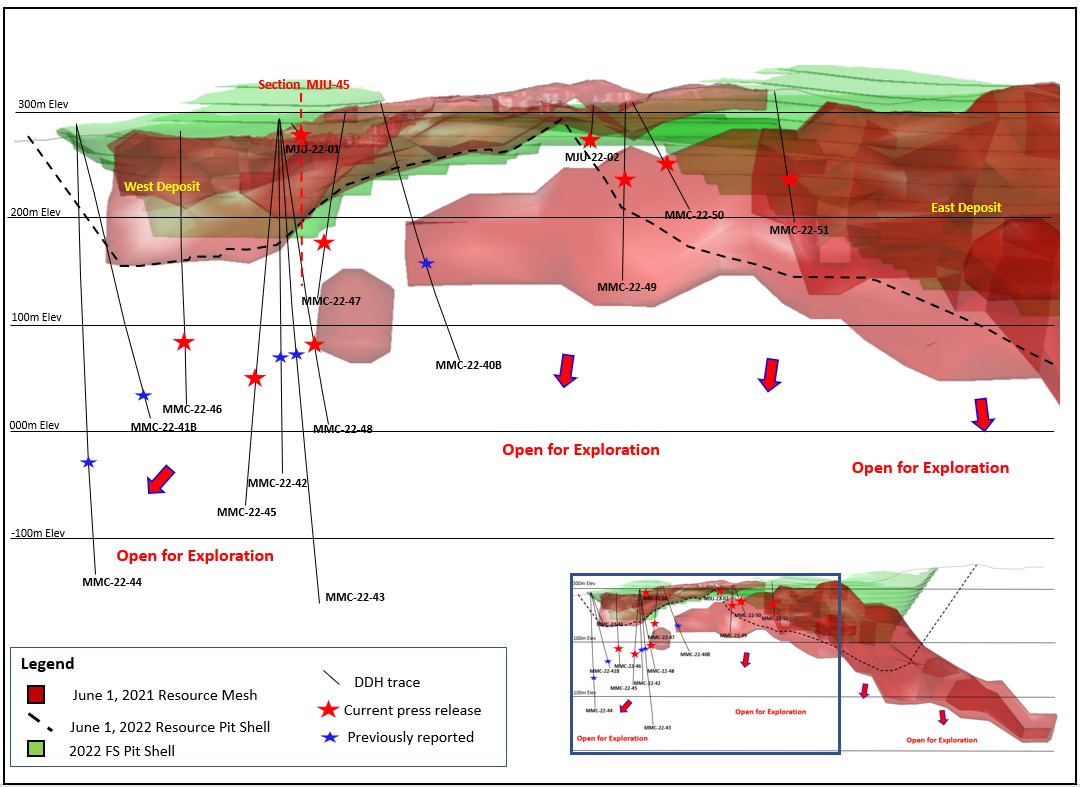
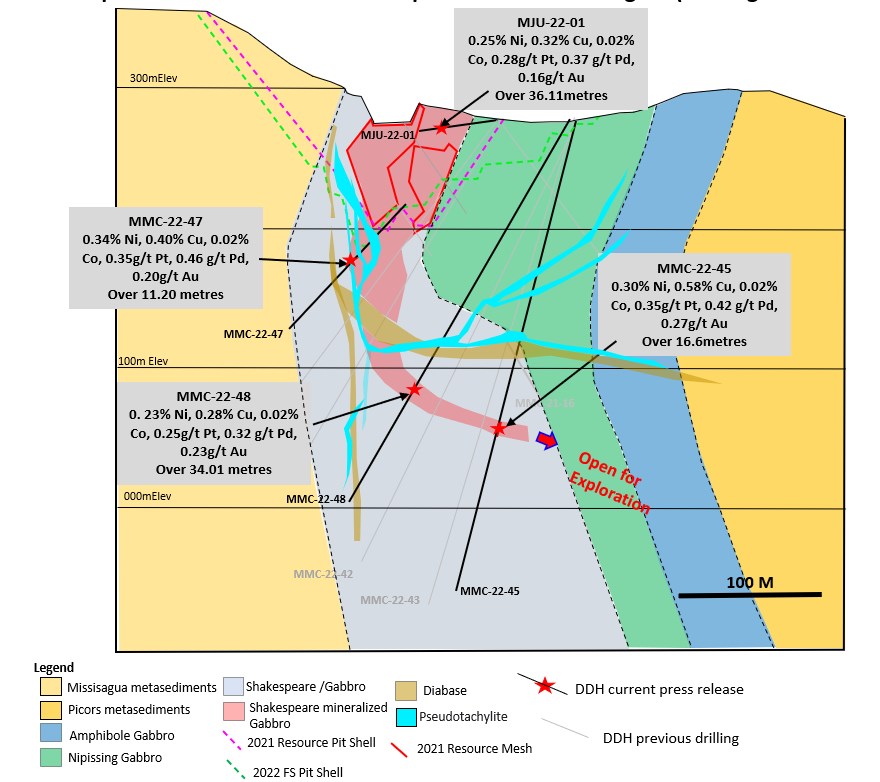
Table 1: Selected 2022 Shakespeare Drilling Assay Results
| DDH | From (m) | To (m) | Length (m) | Ni (%) | Cu (%) | Co (%) | Pt (g/t) | Pd (g/t) | Au (g/t) | |
| MMC-22-45 | 220.14 | 236.74 | 16.60 | 0.30 | 0.58 | 0.02 | 0.35 | 0.42 | 0.27 | |
| including | 226.49 | 233.91 | 7.42 | 0.41 | 0.56 | 0.02 | 0.47 | 0.57 | 0.37 | |
| MMC-22-46 | 241.25 | 244.73 | 3.48 | 0.28 | 0.42 | 0.02 | 0.26 | 0.35 | 0.23 | |
| MMC-22-47 | 14.65 | 15.34 | 0.69 | 0.04 | 1.83 | 0.01 | 0.00 | 0.01 | 0.12 | |
| and | 141.00 | 144.99 | 3.99 | 0.24 | 0.36 | 0.01 | 0.26 | 0.36 | 0.16 | |
| and | 151.81 | 163.01 | 11.20 | 0.34 | 0.40 | 0.02 | 0.35 | 0.46 | 0.20 | |
| including | 157.94 | 163.01 | 5.07 | 0.51 | 0.54 | 0.03 | 0.54 | 0.66 | 0.28 | |
| MMC-22-48 | 214.82 | 248.83 | 34.01 | 0.23 | 0.28 | 0.02 | 0.25 | 0.32 | 0.23 | |
| including | 214.82 | 222.71 | 7.89 | 0.48 | 0.50 | 0.03 | 0.51 | 0.67 | 0.45 | |
| MMC-22-49 | 112.04 | 116.65 | 4.61 | 0.18 | 0.00 | 0.02 | 0.78 | 0.74 | 0.01 | |
| and | 123.24 | 123.62 | 0.38 | 0.19 | 0.79 | 0.01 | 0.40 | 0.41 | 0.10 | |
| MMC-22-50 | 85.00 | 93.00 | 8.00 | 0.26 | 0.25 | 0.02 | 0.23 | 0.27 | 0.19 | |
| and | 99.22 | 110.13 | 10.91 | 0.21 | 0.23 | 0.02 | 0.17 | 0.23 | 0.12 | |
| including | 99.22 | 106.59 | 7.37 | 0.28 | 0.29 | 0.02 | 0.22 | 0.30 | 0.15 | |
| MMC-22-51 | 115.07 | 150.00 | 34.93 | 0.41 | 0.40 | 0.03 | 0.39 | 0.44 | 0.23 | |
| including | 117.88 | 125.11 | 7.23 | 0.50 | 0.55 | 0.03 | 0.49 | 0.62 | 0.31 | |
| and | 160.25 | 182.63 | 22.38 | 0.20 | 0.20 | 0.01 | 0.20 | 0.24 | 0.08 | |
| MJU-22-01 | 23.89 | 60.00 | 36.11 | 0.25 | 0.32 | 0.02 | 0.28 | 0.37 | 0.16 | |
| including | 23.89 | 35.71 | 11.82 | 0.35 | 0.40 | 0.02 | 0.38 | 0.48 | 0.24 | |
| MJU-22-02 | 78.74 | 80.68 | 1.94 | 0.27 | 0.23 | 0.01 | 0.30 | 0.34 | 0.13 | |
| and | 95.93 | 99.10 | 3.17 | 0.27 | 0.25 | 0.01 | 0.30 | 0.34 | 0.05 |
- Drill hole intersection lengths are downhole length.
The above references an opinion and is for information purposes only. It is not intended to be investment advice. Seek a licensed professional for investment advice. The author is not an insider or shareholder of any of the companies mentioned above.
Probe Gold (TSXV:PRB) has reported new results from its Pascalis Gold Trend resource drill program at the Novador project located near Val-D’Or, Quebec. These results come from the first 11,200 metres of drilling across 59 drill holes, which have been successful in confirming continuity of gold zones, through infill drilling. The results also expand near-surface gold mineralization at the North and Beliveau deposits. Probe Gold is calculating a new and update mineral resource estimate for the project that includes these results.
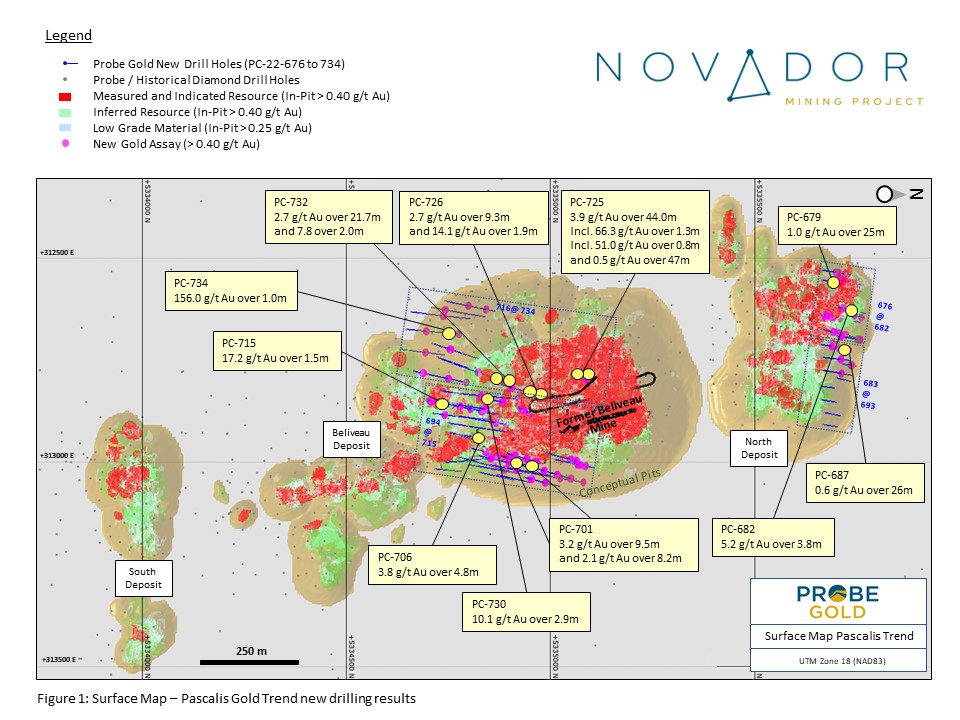
David Palmer, President and CEO of Probe, commented in a press release: “the Novador project continues to improve and grow, with the Beliveau and North deposits returning impressive results in both infill and expansion drilling programs. In addition to strong grades, the deposits are showing excellent consistency and continuity in the mineralized zones, which builds confidence in these substantial development assets. At this stage of the project, with a large resource already in place, these results speak more to the continued growth in scale of the project and our ability to increase the projected annual production. We are currently working towards updated mineral resource estimates on Beliveau, North and Courvan deposits and are looking forward to advancing Novador.”
Highlights from the results are as follows:
- Infill drilling continues to show excellent continuity in mineralization with results grading up to 3.9 g/t Au over 44.0 metres including 66.3 g/t Au over 1.3 metres and 51.0 g/t Au over 0.8 metre, 2.7 g/t Au over 21.7 metres and 3.2 g/t Au over 9.5 metres
- Near-surface expansion drilling returned 156.0 g/t Au over 1.0 metre and 1.0 g/t Au over 25.0 metres.
- Over 15,000 metres of drilling completed year-to-date at Novador – additional 38,000 metres to be completed this year. Six drills are active including four at Monique and two at Pascalis.
- All the results released today will be included in the upcoming resource updates on the Pascalis and Courvan trend deposits expected this Spring.
Drill program on the Beliveau and North deposits in 2022 continued to identify new mineralization within the conceptual pits defined by the 2021 MRE. Of the fifty-nine (59) shallow holes drilled to identify or confirm near-surface mineralization, forty-eight (48) yielded gold intercepts over 0.4 g/t Au, which is above the cut-off grade used in the 2021 pit-constrained resource estimate. The most significant expansion drilling results were found in the extension to the west of the Beliveau deposit and the extension of the North deposit to the north. Infill drilling at Beliveau and North also returned notable results as expected. Shallow gold mineralized structures were intersected in the north and northwest part of the North deposit, which require further follow-up drilling, and all the zones are still open at depth.
The geology and geometry of the mineralization intersected by holes PC-20-676 to 734 are similar to those intersected previously along the Pascalis Gold Trend and consist of shallow dipping tension vein networks closely associated with sub-vertical east-west deformation zones and north-northwest dykes.
Selected drill results from holes PC-22-676 to 734 at the Pascalis Area drilling program are, as follows:
| Hole Number | From (m) | To (m) | Length (m) | Gold (g/t) | Zone / Resource |
| PC-22-676 | 12.0 | 35.0 | 23.0 | 0.5 | Infill / North |
| PC-22-679 | 57.0 | 82.0 | 25.0 | 1.0 | Expansion / North |
| PC-22-682 | 42.7 | 46.5 | 3.8 | 5.2 | Infill / North |
| PC-22-687 | 22.0 | 48.0 | 26.0 | 0.6 | Expansion / North |
| PC-22-701 | 43.5 | 53.0 | 9.5 | 3.2 | Infill / Beliveau |
| PC-22-701 | 160.0 | 168.2 | 8.2 | 2.1 | Infill / Beliveau |
| PC-22-706 | 204.7 | 209.5 | 4.8 | 3.8 | Infill / Beliveau |
| PC-22-715 | 179.0 | 180.5 | 1.5 | 17.2 | Infill / Beliveau |
| PC-22-725 | 6.0 | 50.0 | 44.0 | 3.9 | Infill / Beliveau |
| Including | 32.3 | 33.6 | 1.3 | 66.3 | Infill / Beliveau |
| Including | 36.0 | 36.8 | 0.8 | 51.0 | Infill / Beliveau |
| PC-22-725 | 148.0 | 195.0 | 47.0 | 0.5 | Infill / Beliveau |
| PC-22-726 | 41.0 | 50.3 | 9.3 | 2.7 | Infill / Beliveau |
| PC-22-726 | 136.3 | 138.2 | 1.9 | 14.1 | Infill / Beliveau |
| PC-22-730 | 110.7 | 113.6 | 2.9 | 10.1 | Infill / Beliveau |
| Including | 110.7 | 111.6 | 0.9 | 31.5 | Infill / Beliveau |
| PC-22-732 | 305.4 | 327.1 | 21.7 | 2.7 | Infill / Beliveau |
| PC-22-732 | 374.0 | 376.0 | 2.0 | 7.8 | Infill / Beliveau |
| PC-22-734 | 191.8 | 192.8 | 1.0 | 156.0 | Expansion / Beliveau |
(1) All the new analytical results reported in this release and in this table, are presented in core length and cut to 100 g/t Au when needed. True width is estimated between 65 to 95 % of core length. Only grade times thickness above 15.0 g/t Au * m is reported.
The above references an opinion and is for information purposes only. It is not intended to be investment advice. Seek a licensed professional for investment advice. The author is not an insider or shareholder of any of the companies mentioned above.

Brazil Potash’s Autazes Potash Project promises to be one of the biggest mining investments in Brazil in years, with the company intending to invest $2.5 billion immediately once it obtains its installation license. To prepare, the company has been busy signing offtake agreements to secure the funding when it is needed.
The project financing will rely on the company having advance sales contracts with renowned clients, which Brazil Potash has already begun to do with Amaggi. The first contract with Amaggi was for the purchase of 500,000 tonnes, with a second agreement negotiating the remainder of the mine’s potential of 1.9 million tonnes.
The proposed output for the Autazes Potash Project is also significant because the company plans to double the production numbers. Currently, consultation work is ongoing with the Mura Indigenous group, and is one of the final steps before the company is able to obtain the installation license.
The Changing Potash Market
Three key countries have dominated the potash market in the past: Canada, Belarus, and Russia. This has created issues for food security and pricing stability as the three countries have a monopoly on the market. Brazil Potash’s Autazes Potash Project has the potential to change this, with the company’s CEO, Adriano Espeschit, stating that the project will have a major impact on the global potash market.
The Autazes Potash Project will also add to the diversity of potash production and break up the current monopolistic structure. This could lead to more competitive pricing for potash and create more stability for the market. In addition, the project has the potential to provide jobs and economic growth in the region, as well as stimulate the Brazilian economy.
Beyond the economic impact, the project is a sustainable engineering investment that will produce potassium chloride, an extremely important fertilizer. Brazil is a major agricultural producer, and the Autazes Potash Project could help to ensure that the country has access to the potash it needs for its crops. With current food prices at all-time highs around the world, providing farmers access to better pricing for fertilizers could help balance the market and make it more economical to produce and sell their products.
The company is currently in the pre-production phase and is open for investment, as it continues to explore offtake agreements to ensure the project’s success and future investment of $2.5 billion. That investment would make Brazil Potash one of the largest mining investments in Brazil in years.
The above references an opinion and is for information purposes only. It is not intended to be investment advice. Seek a licensed professional for investment advice. The author is not an insider or shareholder of any of the companies mentioned above.
Red Pine Exploration (TSXV:RPX) has reported new drill results from the ongoing exploration program at the Surluga Deposit, demonstrating the pervasiveness of gold mineralization at over bread areas. This includes intersections in the hanging wall of the Jubilee Shear Zone, Minto B/Jubilee Triangle, and Minto C Shear System located east of the Minto B Shear Zone.

The company’s latest news builds on previous results from the exploration program at the Surluga resource, with further identification of new mineralization structures in the Nyman-Grace mineralized system setting new targets for the program.
Quentin Yarie, President and CEO of Red Pine Exploration commented in a press release: “As we begin our 2023 program focused on resource growth, we continue to evaluate the potential of a hybrid open pit/underground constrained resource (Press release December 06, 2022). In the attached cross section, the continuity of gold mineralization within the Jubilee shear is apparent at lower cut-offs that may be conducive to a shallow open pit with a potential of adding tonnage and ounces to the existing Surluga deposit. Our focus for 2023/24 remains to be an increase in the resource(s) on the Wawa Gold Project.”
Highlights from the results are as follows:
- Significant intersections in the Minto B/Jubilee Triangle (Figure 1) confirm the presence and continuity of gold mineralization in the area where the two structures Minto B and Jubilee shear are converging.
- 0.83 g/t gold over 72.06m in SD-22-404 (Figure 2)
- Includes 1.65 g/t gold over 29.17m including 6.64 g/t gold over 5.87m in the Minto B Shear Zone
- 0.66 g/t gold over 128.85 m in SD-22-417 (Figure 3)
- Includes 3.28 g/t gold over 8.44m in the Jubilee Shear Zone
- 0.83 g/t gold over 72.06m in SD-22-404 (Figure 2)
Several shallow mineralized intersections in the Minto C Shear System located east of the Minto B Shear Zone.
- Includes 1.75 g/t gold over 8.26m including 10.9 g/t over 1.05 m in SD-22-404
- Extension of the Surluga North Vein Network 105 m east of the intersection in SD-22-396 in SD-22-405
- Includes 2.56 g/t gold over 1m in SD-22-405 and 4.3 g/t gold over 1.48m in SD-22-403
- Gold mineralization is proven to extend 450m down-dip of the resource boundary in the Surluga North area at the northern limit of the current Surluga resource.
- Multiple mineralized intersections in the Jubilee Shear system south of the Parkhill Fault
- Includes the intersection of 5.81 g/t gold over 1.49 m in JS-22-398
- Support the persistence of gold mineralization in that underexplored segment of the Jubilee shear system
- Identification of new mineralized structures in the Nyman-Grace mineralized system.
- New results indicate the persistence of the Grace Shear Zone beyond the area where it was mined in the early 20th century.
- New mineralized structures discovered in DG-22-338 north of the Grace Shear Zone


Table 1– Highlights from drilling in the Wawa Gold Corridor (Figure 1)
| Hole | From (m) | To | Length (m)* | Visible Gold | Gold (g/t) | Zone | |
| (m) | |||||||
| SD-22-404 | 19.59 | 21 | 1.41 | 0.68 | Minto C Shear System | ||
| 40.44 | 48.7 | 8.26 | 1.75 | Minto C Shear System | |||
| Including | |||||||
| 47.65 | 48.7 | 1.05 | 10.9 | ||||
| 164 | 168.36 | 4.36 | 0.41 | Shear Zone | |||
| 210.47 | 282.53 | 72.06 | 0.83 | Minto B/Jubilee Triangle | |||
| Including | Minto B/Jubilee Triangle – Minto B Shear Zone | ||||||
| 209.43 | 238.6 | 29.17 | 1.65 | ||||
| That includes | |||||||
| 230.57 | 231.57 | 1 | 14.13 | ||||
| 233.5 | 236.44 | 2.94 | 7.85 | ||||
| Including | Minto B/Jubilee Triangle – Jubilee Shear Zone | ||||||
| 273.43 | 282.53 | 9.1 | 1.37 | ||||
| which includes | |||||||
| 274.46 | 276.46 | 2 | 3.8 | ||||
| 307.37 | 309.51 | 2.14 | 1.14 | ||||
| 340.2 | 341.55 | 1.35 | 0.69 | Shear Zone | |||
| 356.3 | 358.76 | 2.46 | 0.61 | Shear Zone | |||
| SD-22-417 | 67.41 | 73.44 | 6.03 | 1.03 | Minto C Shear System | ||
| 192.32 | 322.17 | 128.85 | 0.66 | Minto B/Jubilee Triangle | |||
| Including | Minto B/Jubilee Triangle – Minto B Shear Zone | ||||||
| 197.57 | 197.42 | 0.85 | 3.75 | ||||
| 205.36 | 206.54 | 1.18 | 3.47 | ||||
| 263.2 | 264.2 | 1 | 4.03 | Minto B/Jubilee Triangle – Jubilee Shear Zone | |||
| 270.56 | 279 | 8.44 | 3.28 | ||||
| which includes | |||||||
| 277 | 279 | 2 | 6.45 | ||||
| 316.8 | 317.8 | 1 | VG | 13 | |||
| 347.2 | 348.5 | 1.3 | 1.13 | Shear Zone | |||
| SD-22-405 | 183.29 | 184.29 | 1 | 0.72 | Surluga North Vein Network | ||
| 196.36 | 197.36 | 1 | 0.48 | ||||
| 200.36 | 217.4 | 17.04 | 0.33 | ||||
| Including | |||||||
| 200.36 | 201.86 | 1.5 | 1.74 | ||||
| 214.4 | 217.4 | 3 | 0.8 | ||||
| 228 | 229 | 1 | 2.56 | ||||
| SD-22-402 | 57.47 | 58.97 | 1.5 | 0.6 | Minto C Shear System | ||
| 180.29 | 181.35 | 1.06 | 0.41 | Minto B Shear Zone | |||
| 190.59 | 194.82 | 4.23 | 0.41 | ||||
| 275.98 | 307.1 | 31.12 | VG | 0.66 | Jubilee Shear Zone – gap in 2 g/t envelope of 2019 resource | ||
| Including | |||||||
| 275.98 | 277.15 | 1.17 | VG | 2.02 | |||
| 285.8 | 288.03 | 2.23 | 2.14 | ||||
| 306.15 | 307.1 | 0.95 | 2.96 | ||||
| SD-22-403 | 208.47 | 209.95 | 1.48 | 4.3 | Surluga North Vein Network | ||
| 344.69 | 347.31 | 2.62 | 1.7 | Surluga North Vein Network | |||
| 418.87 | 423.19 | 4.32 | 1.17 | Jubilee Shear Zone – Surluga North area | |||
| SD-22-357 | 176.34 | 179.93 | 3.59 | 0.8 | Surluga North Vein Network | ||
| 256.5 | 257.26 | 0.76 | 1.54 | ||||
| SD-22-401 | 386.05 | 389.6 | 3.55 | 0.78 | Jubilee Shear Zone – Surluga North area | ||
| 400 | 401.2 | 1.2 | 0.49 | ||||
| SD-22-407 | 42.7 | 51.58 | 8.88 | 0.97 | Minto C Shear System | ||
| Including | |||||||
| 42.7 | 43.62 | 0.92 | 3.57 | ||||
| 49 | 49.82 | 0.82 | 5.72 | ||||
| Jubilee and Minto Stockwork | |||||||
| SD-22-360 | 16.18 | 16.82 | 0.64 | 5.95 | Minto Stockwork/Sadowski Vein System | ||
| SD-22-342 | 638.21 | 639.42 | 1.21 | 1.31 | Jubilee Shear Zone – Northern extension the Surluga South zone | ||
| 710.37 | 712.37 | 2 | 0.88 | ||||
| Darwin-Grace and Jubilee South of the Parkhill Fault | |||||||
| DG-22-338 | 161.47 | 162.83 | 1.36 | 0.76 | Shear Zone – Discoveries | ||
| 189.86 | 191 | 1.14 | 2.43 | ||||
| 198.75 | 199.87 | 1.12 | 2.42 | ||||
| 222.11 | 223.17 | 1.06 | 1.58 | ||||
| 302.45 | 303.45 | 1 | 1.34 | Grace Shear Zone | |||
| DG-22-351 | 99.27 | 100.27 | 1 | 2.05 | Nyman Shear Zone | ||
| JS-22-356 | 242.55 | 243.55 | 1 | 2.55 | Jubilee Shear System south of the Parkhill Fault | ||
| JS-22-369 | 238.89 | 241.06 | 2.17 | 0.5 | Jubilee Shear System south of the Parkhill Fault | ||
| 245.3 | 246.29 | 0.99 | 0.43 | ||||
| 312.23 | 317.68 | 5.45 | 0.46 | ||||
| JS-22-398 | 30.85 | 32.35 | 1.5 | 0.5 | Jubilee Shear System south of the Parkhill Fault | ||
| 48.35 | 49.8 | 1.45 | 1.38 | ||||
| 171.05 | 171.97 | 0.92 | 0.65 | ||||
| 194.11 | 195.6 | 1.49 | 5.81 | ||||
| 223.29 | 224.46 | 1.17 | 0.59 | ||||
Assay results presented over core length. True width for the intersections varies between 35 to 90% depending on the intersected geological structure
The above references an opinion and is for information purposes only. It is not intended to be investment advice. Seek a licensed professional for investment advice. The author is not an insider or shareholder of any of the companies mentioned above.
Bravo Mining (TSXV:BRVO) has reported new assay results from the Luanga palladium + platinum + rhodium + gold + nickel project, from eight diamond drill holes in the Central and North Sectors. The discovery highlights the nickel sulphide potential of the project which is located in the Carajás Mineral Province, state of Pará, Brazil.
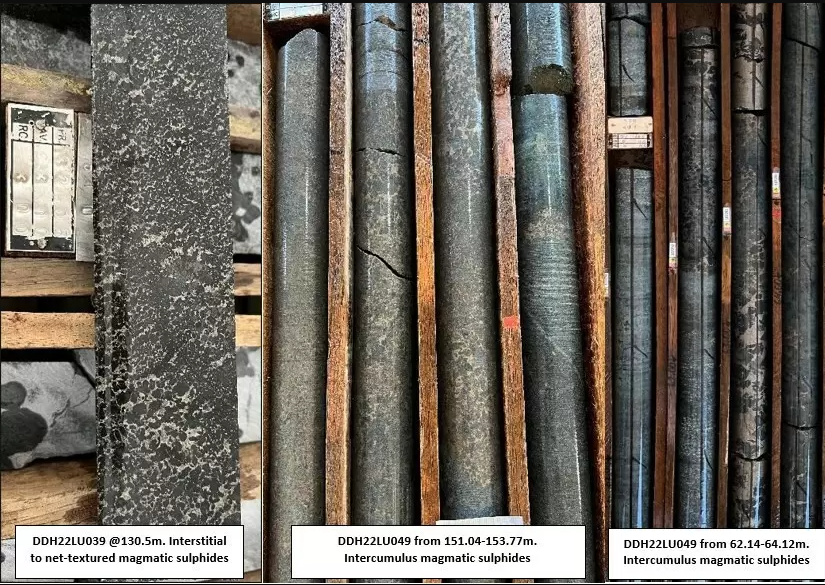
Two DDH in the Central Sector of the project identified a new zone and style of nickel sulphide mineralization. Follow-up drilling has intersected higher-grade nickel sulphide 50m to the north and south of the North Sector with some evidence indicating potential extensions toward the south.
Luis Azevedo, Chairman and CEO of Bravo Mining, commented in a press release: “Today’s results demonstrate the potential for higher-grade nickel ± copper sulphides at Luanga, underlie the existing ~8.1km strike of PGM+Au+Ni mineralization intersected in shallow historic drilling. We are at the early stages of understanding the distribution of, and controls on, this potential new style of nickel ± copper sulphide mineralization, which has now been intersected in both the North and Central Sectors,” he said. “We are very positive about the potential below Luanga and have deployed geophysical tools aimed at detecting this style of mineralization. Work is continuing and aims to drill test future geophysical targets in 2023.”
Highlights from the results are as follows:
- Highlights include 27.7m @ 0.62g/t PGM+Au, 0.62% Ni (Including 4.6m @ 1.12g/t PGM+Au plus 1.12% Ni),
- And: 25.3m @ 1.14g/t PGM+Au, 0.42% Ni, 0.34% Cu (Including 3.4m @ 2.12g/t PGM+Au, 0.84% Ni, 0.34% Cu)
- Follow up, step-out drilling to the massive nickel/copper sulphides intercepted in DDH22LU047 (August 16th, 2022 news release) intersected nickel/copper sulphides along strike, 50m to the north and to the south. Electromagnetics (EM) has identified conductors trending to the south where surface EM is ongoing.
- Drilling in the Central Sector of Luanga has intersected a new zone and style of nickel sulphide mineralization, potentially magmatic nickel sulphide mineralization. It occurs within a different rock-type than the PGM+Au+Ni mineralization at Luanga – further increasing the exploration prospectivity of Luanga. EM surveying is expected to begin shortly.
- A noticeable change in PGM chemistry (significantly higher rhodium to palladium ratio) has been identified in most assay results from both nickel sulphide zones. This also points to a new style of mineralization and provides another possible vector into higher nickel sulphide zones.
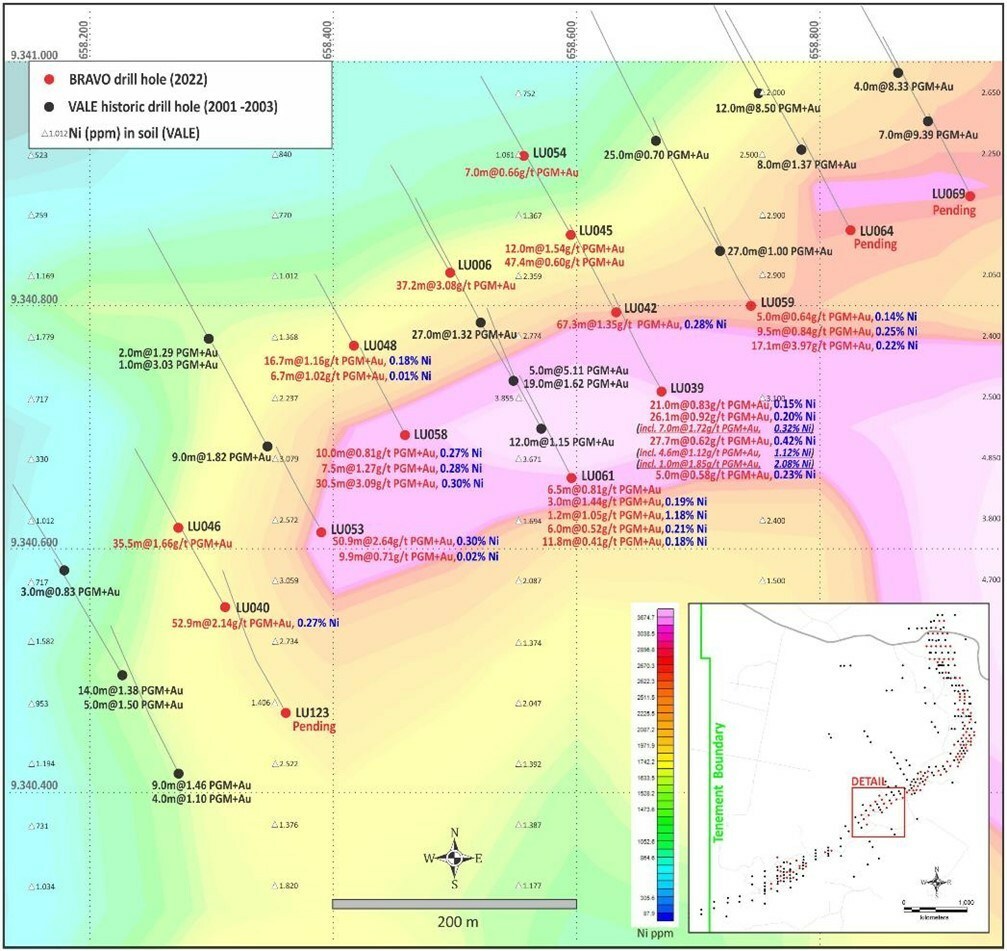
| HOLE-ID | From
(m) |
To
(m) |
Thickness
(m) |
Pd
(g/t) |
Pt
(g/t) |
Rh
(g/t) |
Au (g/t) | PGM + Au (g/t) | Ni (% Sulphide) | Cu (%) | Sector |
| DDH22LU039 | 128.2 | 155.9 | 27.7 | 0.40 | 0.10 | 0.11 | 0.01 | 0.62 | 0.42 | Cent. | |
| Including | 128.2 | 132.8 | 4.6 | 0.74 | 0.12 | 0.25 | 0.01 | 1.12 | 1.12 | Cent. | |
| Including | 130.2 | 131.2 | 1.0 | 1.08 | 0.25 | 0.51 | 0.01 | 1.85 | 2.08 | Cent. | |
| DDH22LU049 | 49.6 | 74.9 | 25.3 | 0.68 | 0.22 | 0.13 | 0.12 | 1.14 | 0.40 | 0.23 | North |
| Including | 66.9 | 70.3 | 3.4 | 1.18 | 0.52 | 0.29 | 0.12 | 2.12 | 0.84 | 0.34 | North |
| DDH22LU052 | 151.0 | 158.1 | 7.1 | 0.69 | 0.04 | 0.30 | 0.11 | 1.13 | 0.82 | 0.45 | North |
| Including | 151.0 | 153.8 | 2.8 | 0.76 | 0.02 | 0.39 | 0.01 | 1.18 | 1.09 | 0.22 | North |
| DDH22LU061 | 102.4 | 103.6 | 1.2 | 0.55 | 0.04 | 0.31 | 0.15 | 1.05 | 1.18 | Cent. | |
| DDH22LU073 | 136.9 | 155.8 | 18. 9 | 0.96 | 0.29 | 0.02 | 0.02 | 1.30 | 0.41 | North | |
| Including | 150.8 | 153.8 | 3.0 | 2.57 | 0.50 | 0.04 | 0.02 | 3.14 | 1.15 | North | |
| DDH22LU077 | 169.4 | 175.5 | 6.1 | 0.57 | 0.04 | 0.33 | 0.02 | 0.96 | 0.63 | North | |
| Including | 169.4 | 171.3 | 1.9 | 1.33 | 0.05 | 0.84* | 0.04 | 2.27* | 1.47 | North | |
| Including | 170.6 | 171.3 | 0.7 | 1.54 | 0.04 | >1.0* | 0.01 | 2.59* | 2.27 | North |
| Notes: All ‘From’, ‘To’ depths, and ‘Thicknesses’ are downhole. |
| All intercepts were in fresh rock. |
| Given the orientation of the hole and the mineralization, the intercepts are estimated to be 85% to 100% of true thickness. |
| * Includes Rh >1.00g/t result. Overlimit analyses pending. |
| North = North Sector. Cent. = Central Sector.
** Bravo’s nickel grades are sulphide nickel, and do not include non-recoverable silicate nickel, unlike historic total nickel assays. |
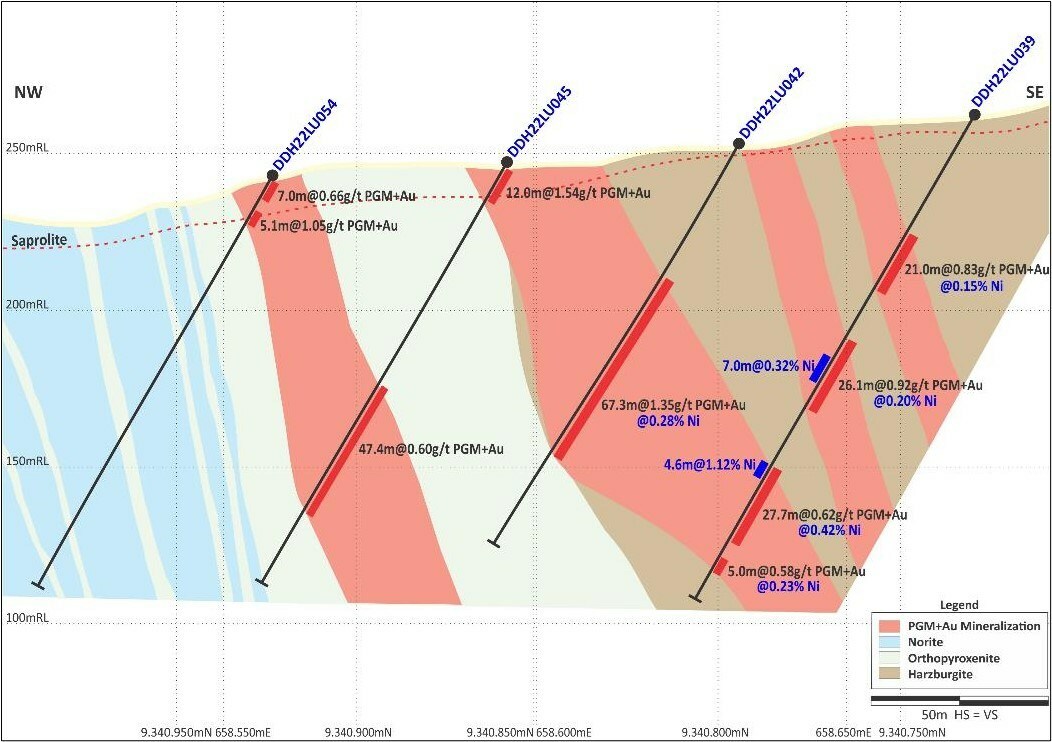
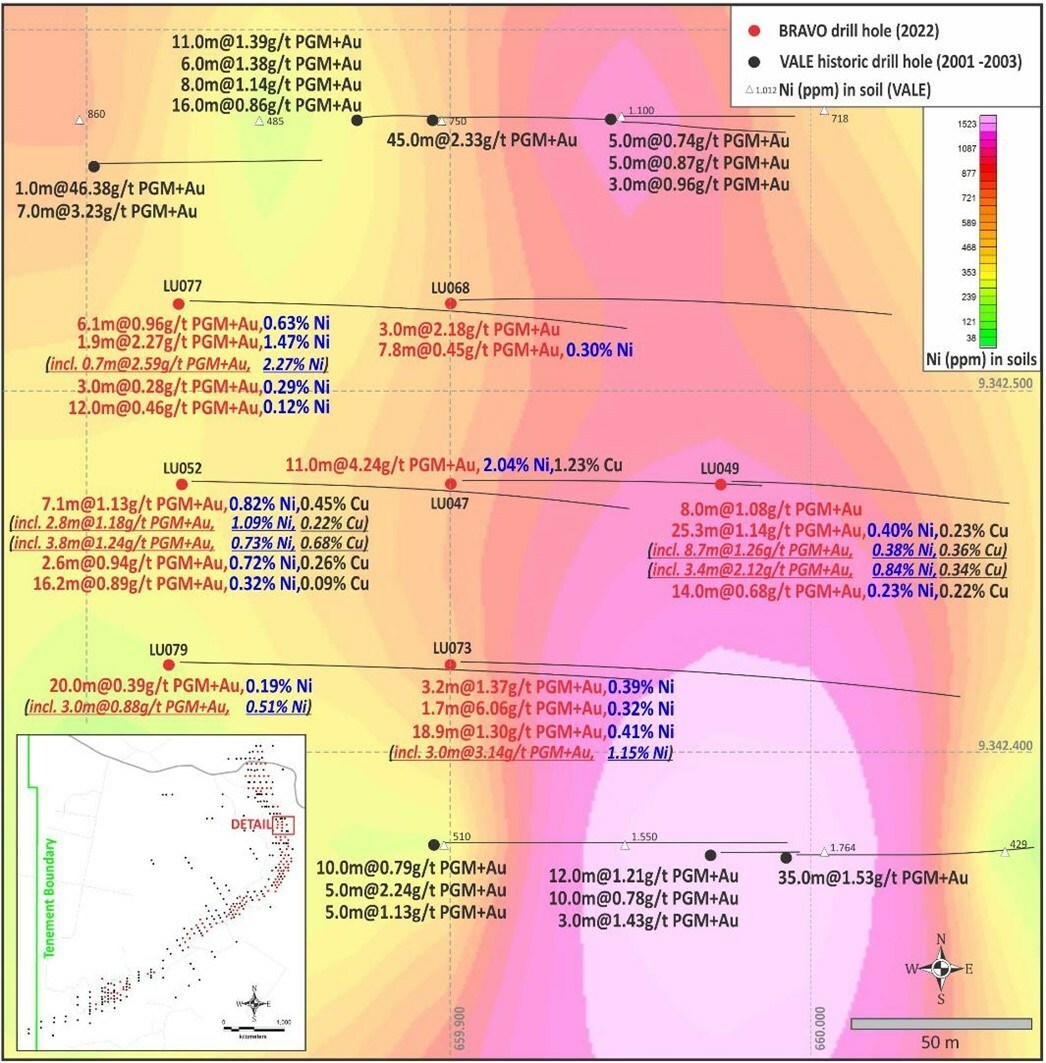
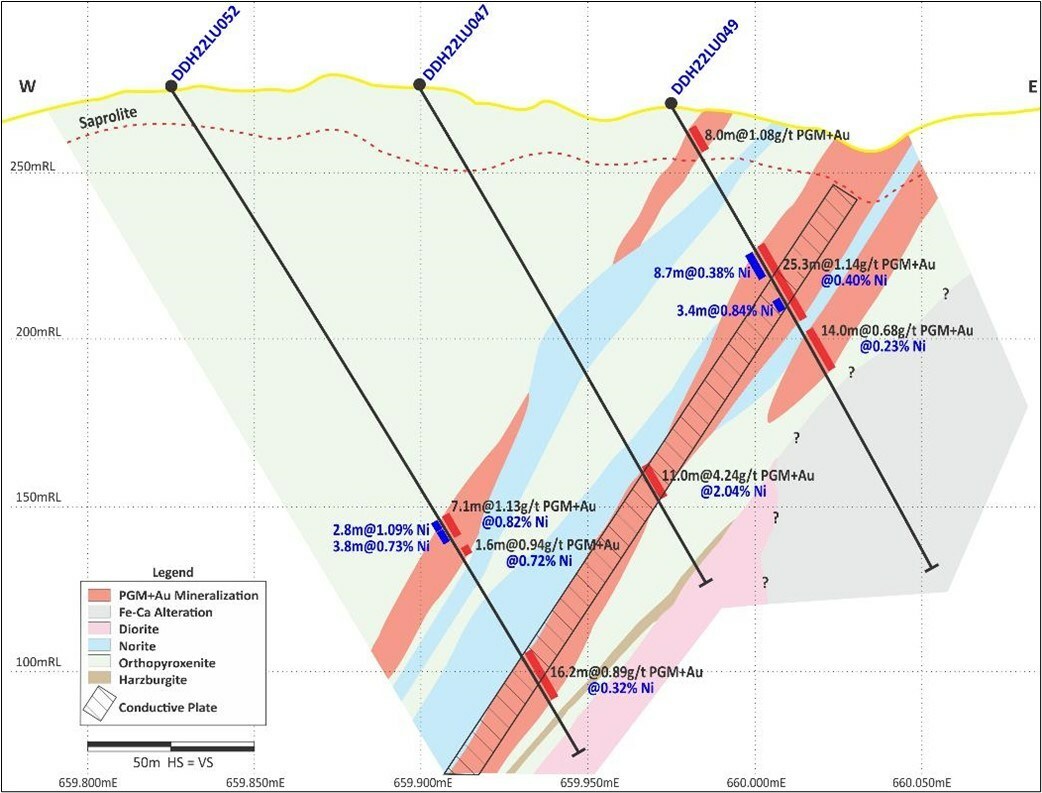
The above references an opinion and is for information purposes only. It is not intended to be investment advice. Seek a licensed professional for investment advice. The author is not an insider or shareholder of any of the companies mentioned above.
Jaguar Mining (TSX:JAG) has reported new results from exploration and growth activities at the Turmalina Complex in Minas Gerais, Brazil. The company has continued to expand on previous results at the project from several priority diamond drill campaigns begun in the fourth quarter of 2022. These campaigns focussed on high-grade extensions of mineralizations discovered earlier in 2022.

New exploration diamond drilling was focussed on high-grade mineralization in the C Structure at Turmalina, follow-up step-out drilling at the Pontal South Discovery, as well as high-grade targets within the B Structure, which were also at shallow levels in the mine.

Jaguar Mining sees the results so far as encouraging, with high grades over mineable widths reported from various areas within the C and B Mineralized Structures, including the identification of a new structure within the footwall of the C Structure.
At the Pontal South Discovery, the company’s step-out drilling has demonstrated continuity of high-grade mineralization to depth down plunge. Jaguar Mining is also drilling at the Faina Growth Project, completing approximately 15,359 metres of infill resource conversion drilling across 46 holes with the goal of converting the published Inferred Mineral Resource to an Indicated Mineral Resource.

Drilling at the Faina Growth Project confirmed high-grade characteristics of this mineralization and continuity within the deposit. Drilling also underpins geological and grade models for the important project. Jaguar Mining expects to publish updated Mineral Reserves and Mineral Resources with the AIF sometime in March 2023.

Vern Baker CEO of Jaguar Mining, commented in a press release: “I am very excited about the positive drill results reported today as they support the Company’s organic growth plans and ultimately our future production profile. The high grades in the C and B Structures are at shallow levels and close to development in these sectors of the mine which justifies our plan to focus production in these areas and support ongoing underground access development towards the Faina Resource. The success of infill drilling at Faina and the continued definition of new mineralized areas along the main structural trend continue to demonstrate the upside potential of this trend.”

Highlights from the results are as follows:
- 22.87 g/t Au over an estimated true width of 5.4m in Orebody CNW
- 13.54 g/t Au over an estimated true width of 6.4m in Orebody B
- 7.98 g/t Au over 5.2m* in Pontal South
- 9.51 g/t Au over 9.8m*in Faina Resource Conversion Infill Drilling * (Drilled width – true width unknown)
C- Structure Mineralization
11.56 g/t Au over 4.6m
8.08 g/t Au over 6.8m
22.87 g/t Au over 5.4m
B- Structure Mineralization
11.58 g/t Au over 7.6m
9.60 g/t Au over 6.2m
13.54 g/t Au over 6.4m
Pontal South Exploration Target
2.44 g/t Au over 19.6 m* (including 3.28 g/t Au over 12.7m*)
4.69 g/t Au over 10.1 m* (including 7.98 g/t Au over 5.2m*)
* (Drilled widths -true width unknown)
Faina Project Infill Drilling Results
4.40 g/t Au over 23.3m* (including 9.51 g/t Au over 9.8 m*)
7.10 g/t Au over 11.0m* (including 8.20 g/t Au over 9.0m*)
9.57 g/t Au over 6.80 m* (including 77.7 g/t Au over 0.8 m*)
* (Drilled widths -true width unknown))

Table 1 – Best Drilling Intersections C-Structure with Grade x Thickness (GT) > 25 in the Turmalina Complex
| Summary of Diamond Drill Intersections
Orebody C Structure Turmalina Mine |
||||||
| Hole ID | From (m) | To (m) | DownHole Interval (m) | Estimated True Width (ETW) (m) | Gold Grade (g/t Au) | GT
(Grade x ETW) |
| FTS2165 | 60.4 | 70.3 | 9.82 | 6.6 | 3.88 | 26 |
| FTS2280 | 132.4 | 138.8 | 6.34 | 4.6 | 11.56 | 53 |
| FTS2285 | 147.1 | 155.8 | 8.67 | 6.80 | 8.08 | 55 |
| FTS2218 | 159.7 | 165.7 | 6.05 | 5.4 | 22.87 | 124 |
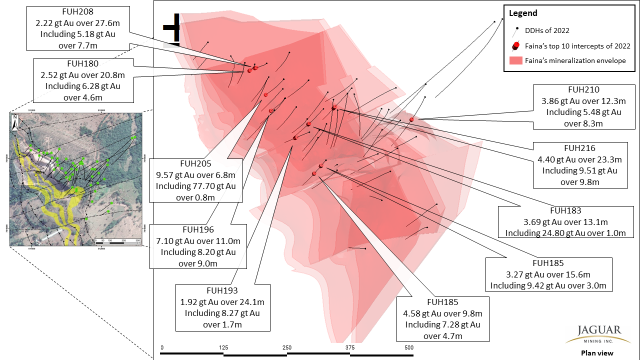
Table 2 – Best Drilling Intersections B-Structure
| Summary of Diamond Drill Intersections
Orebody B Structure Turmalina Mine |
||||||
| Hole ID | From (m) | To (m) | DownHole Interval (m) | Estimated
True Width (ETW) (m) |
Gold Grade (g/t Au) | GT
(Grade x ETW) |
| GR390LM01 | 65.3 | 84.4 | 19.1 | 7.6 | 11.58 | 88 |
| B390LM12 | 4.6 | 11.6 | 7.0 | 6.2 | 9.60 | 59 |
| B390LM11 | 2.3 | 9.8 | 7.5 | 6.4 | 13.54 | 86 |
Table 3 – Best Drilling Intersections Pontal South
| Summary of Diamond Drill Intersections
Orebody Pontal South Structure |
|||||
| Hole ID | From (m) | To (m) | DownHole Interval (m) | Gold Grade (g/t Au) | GT*
(Grade x Thickness) |
| PTL105 | 255.0 | 265.1 | 10.1 | 4.69 | 47 |
| Including | 258.0 | 263.2 | 5.2 | 7.98 | 41 |
GT*: (Drilled width – true width unknown)
Table 4 – Faina Resource Conversion Infill Drilling – Best Intersections
| Summary of Diamond Drill Intersections | |||||
| Faina Resource Conversion Infill Drilling – Best Intersections | |||||
| Hole ID | From (m) | To (m) | DownHole Interval (m) | Gold Grade (g/t Au) | GT*
(Grade x Thickness) |
| FUH180 | 216.2 | 236.9 | 20.8 | 2.52 | 52 |
| Including | 222.4 | 227.0 | 4.6 | 6.28 | 29 |
| FUH183 | 192.6 | 205.7 | 13.1 | 3.69 | 48 |
| Including | 204.7 | 205.7 | 1.0 | 24.80 | 25 |
| FUH185 | 61.9 | 77.5 | 15.6 | 3.27 | 51 |
| Including | 74.5 | 77.5 | 3.0 | 9.42 | 28 |
| FUH185 | 158.9 | 168.7 | 9.8 | 4.58 | 45 |
| Including | 164.0 | 168.7 | 4.7 | 7.28 | 34 |
| FUH193 | 146.8 | 170.9 | 24.1 | 1.92 | 46 |
| Including | 160.6 | 162.3 | 1.7 | 8.27 | 14 |
| FUH196 | 279.0 | 290.0 | 11.0 | 7.10 | 78 |
| Including | 280.0 | 289.0 | 9.0 | 8.20 | 74 |
| FUH205 | 289.2 | 296.0 | 6.8 | 9.57 | 65 |
| Including | 289.2 | 290.0 | 0.8 | 77.70 | 62 |
| FUH208 | 196.5 | 224.0 | 27.6 | 2.22 | 61 |
| Including | 201.5 | 209.2 | 7.7 | 5.18 | 40 |
GT*: (Drilled width – true width unknown)
The above references an opinion and is for information purposes only. It is not intended to be investment advice. Seek a licensed professional for investment advice. The author is not an insider or shareholder of any of the companies mentioned above.
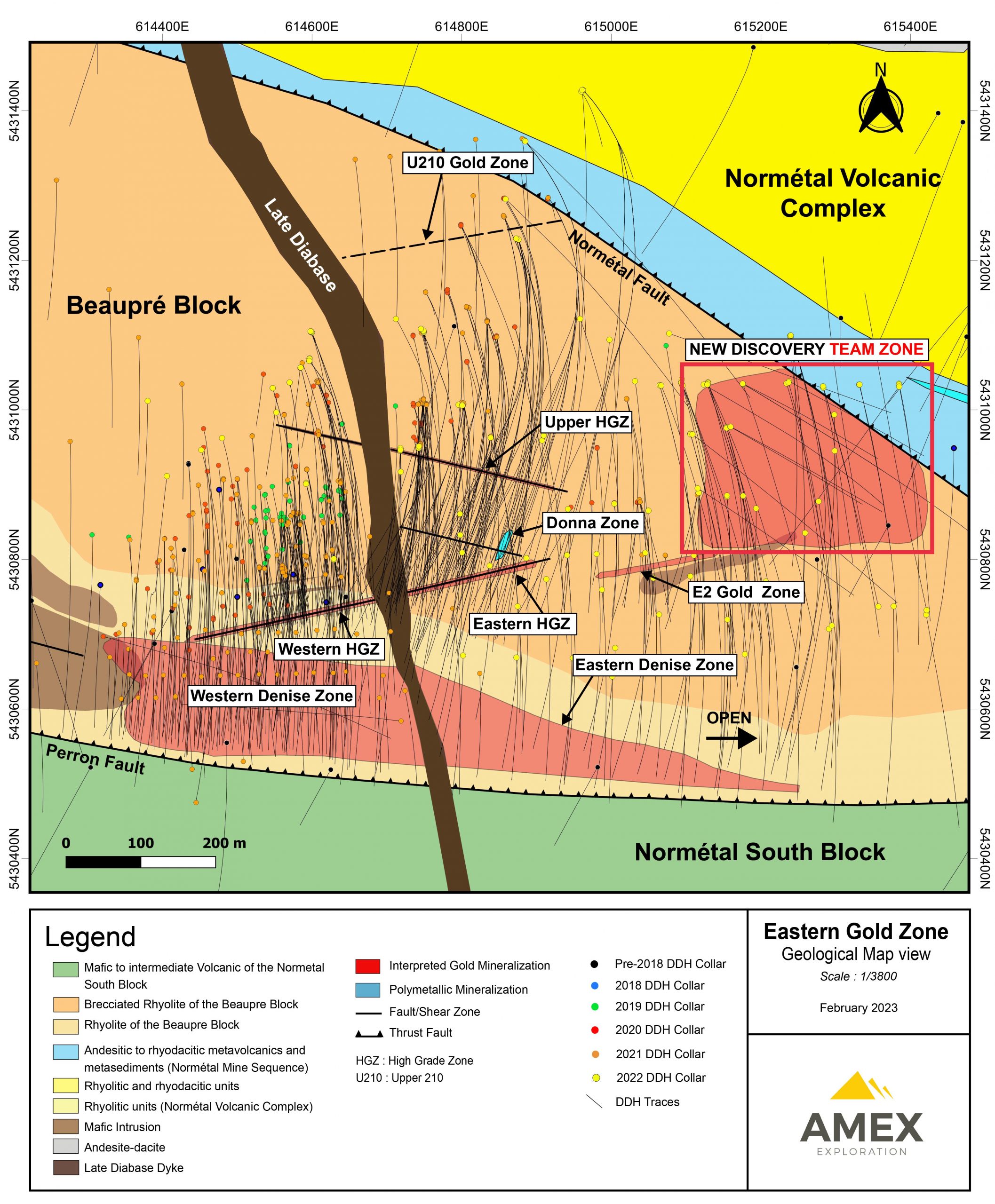
Amex Exploration (TSXV:AMX) has reported new results from ongoing drilling at the Team Zone on the Perron project in the Abitibi region of Quebec. Team Zone occurs approximately 600m to the northeast of the High Grae Zone and roughly 300m northeast of the E2 Gold Zone, encompassing an approximate area of 300m by 250m from surface to a depth of approximately 400m. The Team Zone is currently open at depth and along strike and is the newest target generated from the company’s regional exploration campaign from the last year.
Jacques Trottier, Executive Chairman of Amex, commented in a press release: “The Team Zone is shaping up to be a significant component of the overall mineralized system at Perron. It has now delivered gold mineralization in each drill hole, with a mix of both high-grade vein-hosted gold and lower grade stockwork and disseminated mineralization. Today’s results, particularly in hole PE-22-580 with high grades up to 72.06 gram of gold over 1.00 metre, confirm the potential at depth in this system, and the balance of the drillholes affirm our earlier expectations of a widespread near surface orebody. In addition to the known mineralization, the Team Zone adds significantly to our regional targeting as it is a different style of mineralization than encountered elsewhere.”
Highlights from the results are as follows:
PE-22-568: 4.73 g/t Au over 8.20 m at a vertical depth of ~115 m
Including: 27.07 g/t Au over 1.00 m
PE-22-570: 2.71 g/t over 10.50 m at a vertical depth of ~100 m
Including: 38.97 g/t Au over 0.50 m
PE-22-571: 2.69 g/t Au over 5.00 m at a vertical depth of ~50 m
PE-22-580: 9.21 g/t Au over 3.90 m at a vertical depth of ~210 m
And: 0.84 g/t Au over 14.40 m at a vertical depth of ~240 m
And: 72.06 g/t Au over 1.00 m at a vertical depth of ~305 m
PE-22-583: 1.04 g/t Au over 26.00 m at a vertical depth of ~394 m
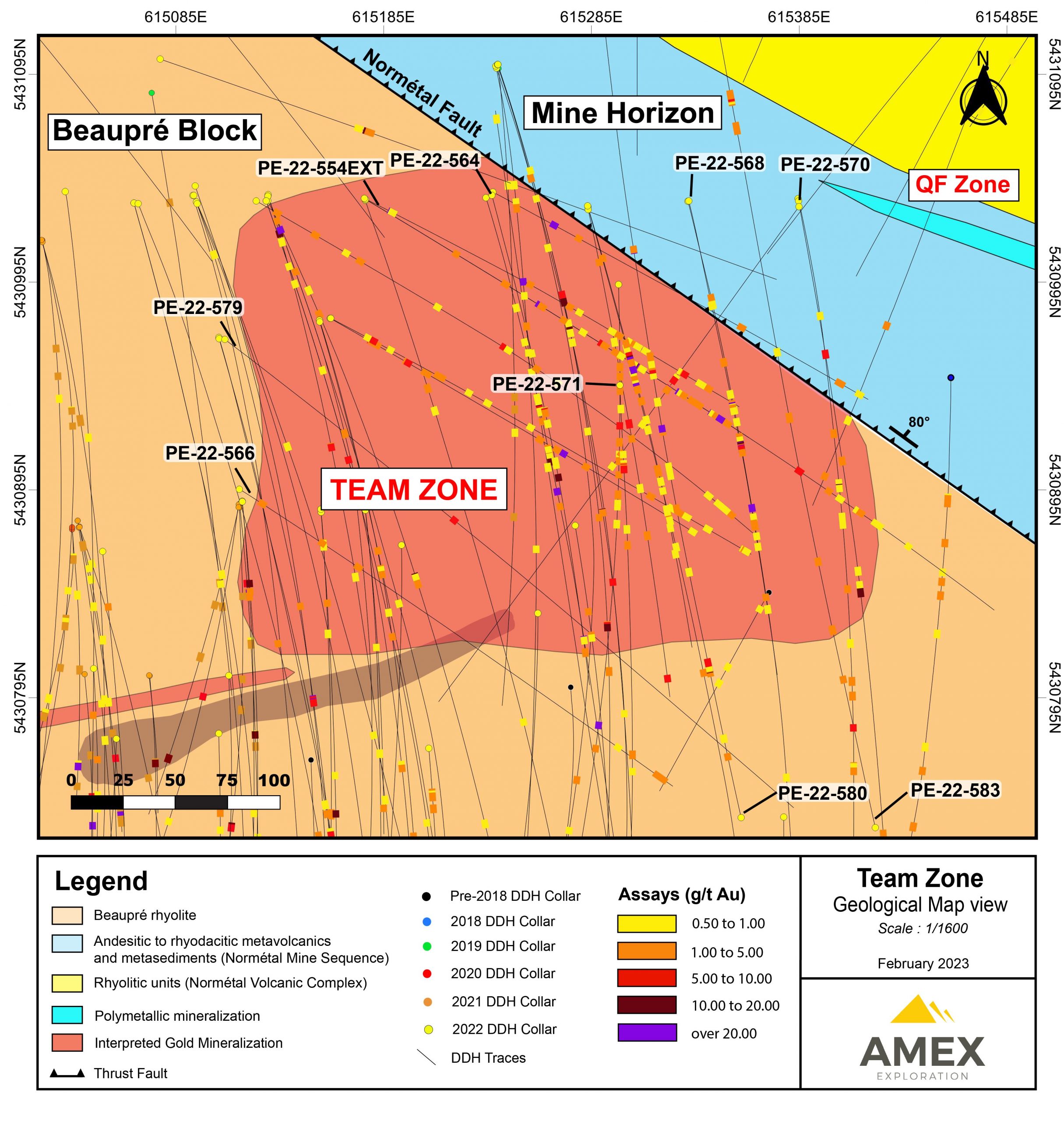
Today’s results represent continued testing of the extents, grade, and dimensions of the new Team Zone. Drilling was conducted in several orientations (as shown in Table 2) in order to identify controls on mineralization. The Team Zone is shaping up to be a shallowly eastward-plunging body which begins at surface and is open to depth and to the east. The large overall mineralized trend is driven by several higher-grade areas as can be seen in Figure 2. Further work is required to fully define the higher-grade sub-structures. The Zone is also parallel and adjacent to the E2 Gold Zone to the southwest, and to the 210 & Upper 210 to the northwest. Structural interpretation indicates that the Upper 210 may occur on a similar structure to that of the Team Zone, and further drilling is required to test if they are connected. See Table 1 for a list of the today’s drill results, Table 2 for drill hole coordinates, Figure 1 for a map of the Perron project geology showing the location of the Team Zone, Figure 2 for a map showing the distribution of assayed gold identified to date throughout the Team Zone, and Figure 3 for photos of visible gold in several holes in the Team Zone.
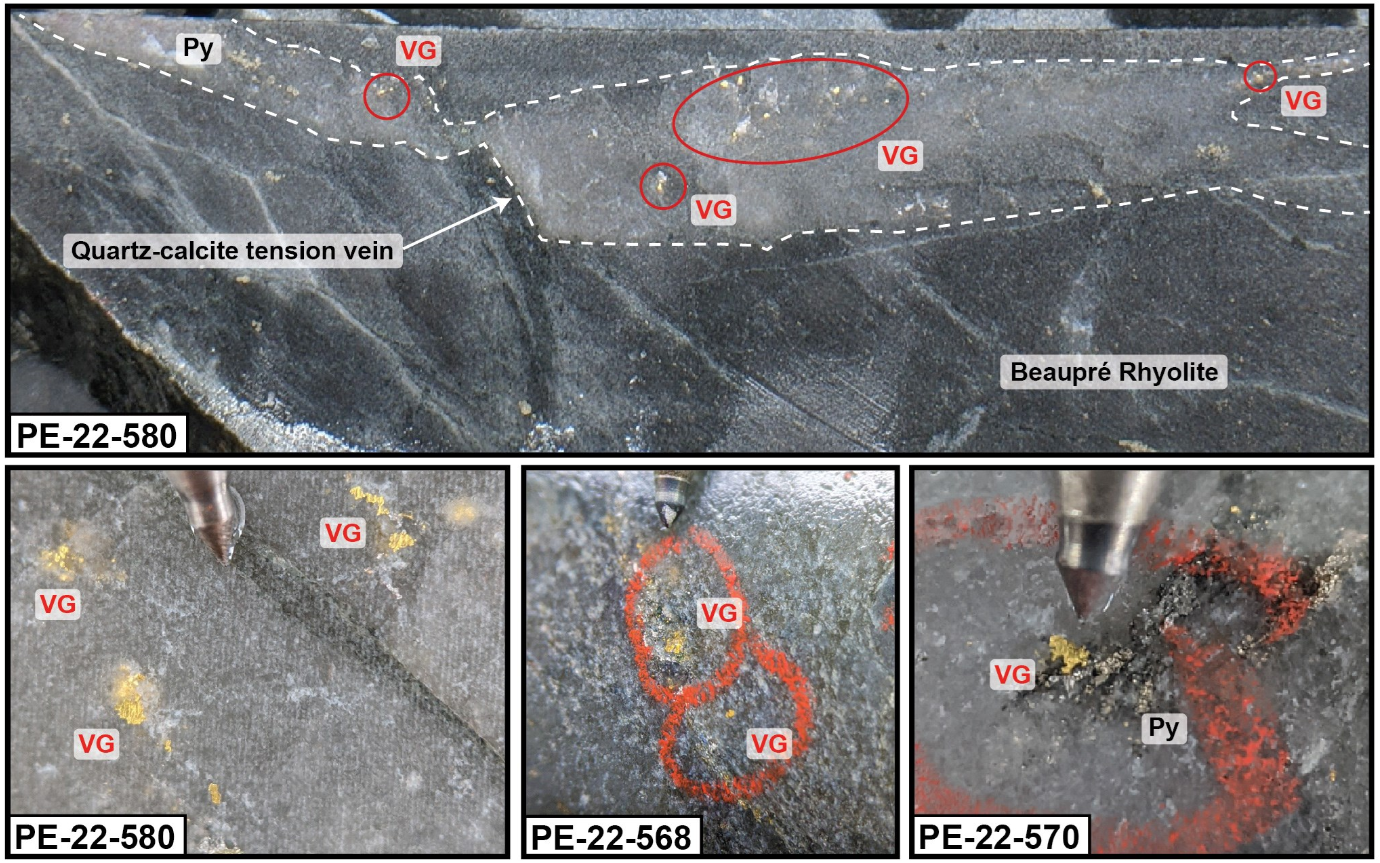
Table 1. Assay results from the Team Zone at Perron. Note that true width is currently unknown and thus core lengths are shown.
| Hole ID | From
(m) |
To
(m) |
Core Length
(m) |
Au g/t | Vertical depth (m) |
| PE-22-554EXT | 375.00 | 376.50 | 1.50 | 8.54 | ~280 to 325 |
| And | 401.50 | 402.00 | 0.50 | 1.93 | |
| And | 426.50 | 431.50 | 5.00 | 0.59 | |
| PE-22-564 | 162.65 | 173.00 | 10.35 | 0.74 | ~120 to 250 |
| Including | 162.65 | 165.00 | 2.35 | 2.73 | |
| And | 199.50 | 213.50 | 14.00 | 0.66 | |
| And | 335.00 | 336.50 | 1.50 | 3.53 | |
| PE-22-566 | 74.50 | 75.20 | 0.70 | 1.80 | ~60 to 285 |
| And | 107.00 | 108.50 | 1.50 | 1.13 | |
| And | 371.20 | 377.50 | 6.30 | 0.96 | |
| PE-22-568 | 152.70 | 160.90 | 8.20 | 4.73 | ~115 to 220 |
| Including | 156.50 | 157.50 | 1.00 | 27.07 | |
| And | 242.50 | 245.00 | 2.50 | 0.97 | |
| And | 295.00 | 295.50 | 0.50 | 1.95 | |
| PE-22-570 | 144.50 | 155.00 | 10.50 | 2.71 | ~100 to 140 |
| Including | 153.50 | 154.00 | 0.50 | 38.97 | |
| And | 206.50 | 207.00 | 0.50 | 3.72 | |
| PE-22-571 | 60.00 | 65.00 | 5.00 | 2.69 | ~50 to 100 |
| And | 121.50 | 123.50 | 2.00 | 1.78 | |
| PE-22-579 | 193.00 | 194.00 | 1.00 | 4.01 | ~135 |
| PE-22-580 | 281.10 | 285.00 | 3.90 | 9.21 | ~210 to 305 |
| And | 322.70 | 337.10 | 14.40 | 0.84 | |
| Including | 326.70 | 330.60 | 3.90 | 2.03 | |
| And | 411.40 | 412.40 | 1.00 | 72.06 | |
| Including | 411.40 | 411.90 | 0.50 | 141.82 | |
| PE-22-583 | 150.30 | 152.50 | 2.20 | 4.65 | ~115 to 395 |
| And | 201.65 | 203.00 | 1.35 | 1.66 | |
| And | 306.00 | 308.50 | 2.50 | 2.35 | |
| And | 509.70 | 535.70 | 26.00 | 1.04 | |
| Including | 529.50 | 535.70 | 6.20 | 2.98 |
Table 2. Team Zone drill hole coordinates.
| Hole Id | Azimuth
(°) |
Dip
(°) |
Start
(m) |
End
(m) |
Length
(m) |
Easting
(m) |
Northing
(m) |
Elevation
(m) |
| PE-22-554EXT | 120 | -50 | 330.75 | 550 | 219.25 | 615362 | 5430924 | 101 |
| PE-22-564 | 165 | -50 | 0 | 358 | 358 | 615237 | 5431037 | 352 |
| PE-22-566 | 120 | -50 | 0 | 385 | 385 | 615116 | 5430895 | 347 |
| PE-22-568 | 166 | -51 | 0 | 349 | 349 | 615332 | 5431034 | 351 |
| PE-22-570 | 216 | -48 | 0 | 405.75 | 405.75 | 615385 | 5431031 | 355 |
| PE-22-571 | 178 | -51 | 0 | 670 | 670 | 615299 | 5430945 | 343 |
| PE-22-579 | 128 | -45 | 0 | 478 | 478 | 615109 | 5430967 | 347 |
| PE-22-580 | 347 | -52 | 0 | 688 | 688 | 615357 | 5430737 | 344 |
| PE-22-583 | 347 | -51 | 0 | 634 | 634 | 615422 | 5430732 | 345 |
The above references an opinion and is for information purposes only. It is not intended to be investment advice. Seek a licensed professional for investment advice. The author is not an insider or shareholder of any of the companies mentioned above.
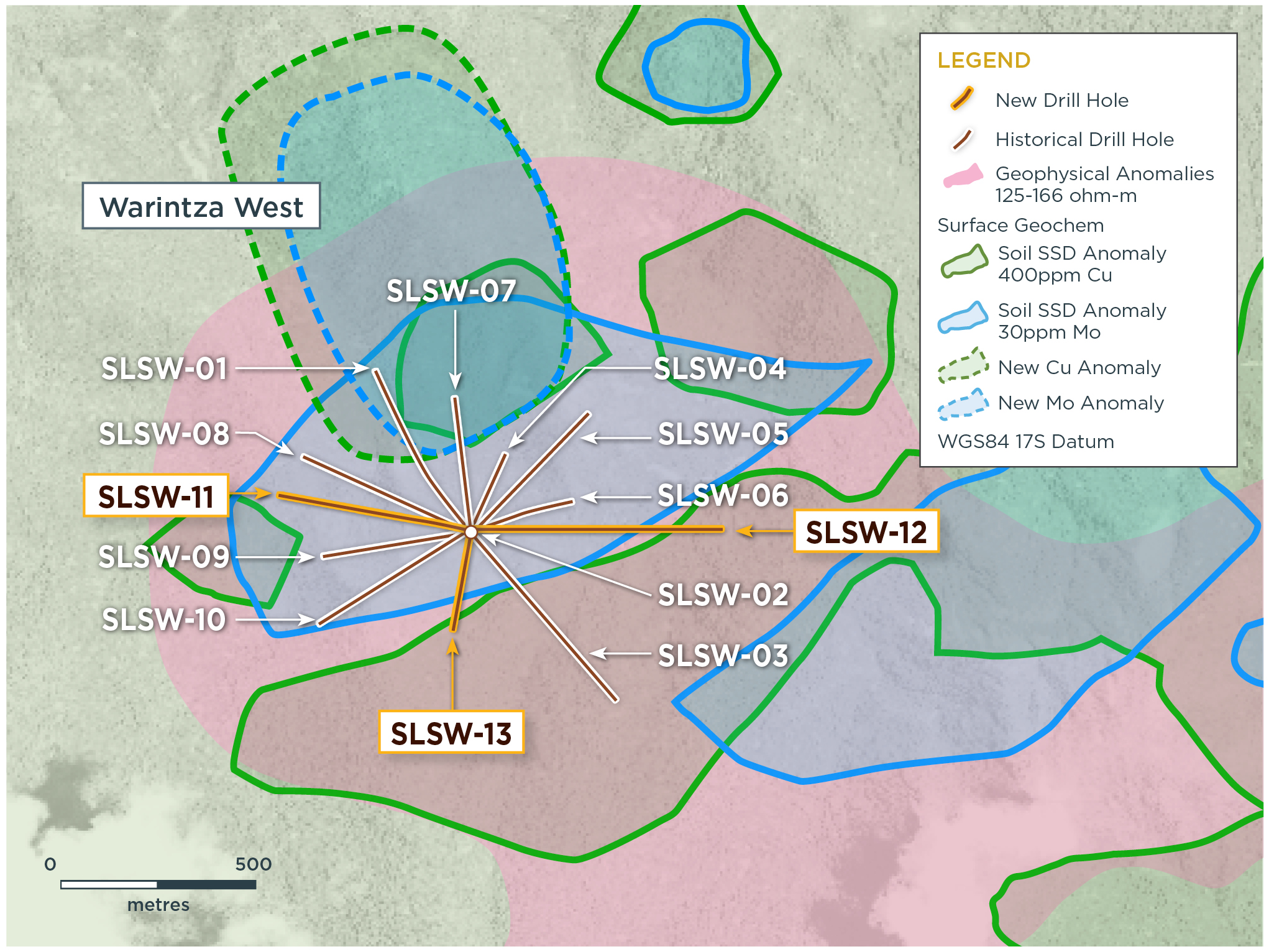
Solaris Resources (TSX:SLS) has reported new updated geochemical sampling and assay results from follow-up holes at Warintza West within the Warintza Project in Ecuador. The company has identified new potential at the zone, which was one of four discoveries made to-date in the Warintza porphyry cluster located 1km west of and outside the Warintza Mineral Resources (MRE).
The company has performed reconnaissance drilling with the initial holes from the centralized platform outlining a broad zone of porphyry mineralization measuring 1200m z 700m, and remains open. Geochemical sampling provided vectors toward more potential higher-grade mineralization to the north for step-out drilling, expanding on Warintza’s potential for further future discoveries.
Mr. Jorge Fierro, Vice President, Exploration, commented in a press release: “First pass reconnaissance drilling at Warintza West outlined a broad zone of porphyry mineralization, with subsequent sampling identifying new potential for higher-grade mineralization to the north for future step-out drilling. The ongoing drill program is targeting MRE growth within the high-grade starter pit at Warintza Central, where results are expected shortly, and expanding the Warintza East discovery which adjoins Warintza Central.”
Highlights from the results are as follows:
- Recent geochemical sampling has identified a new area of strong overlapping copper and molybdenum anomalies to the north measuring approximately 1000m x 500m with soil samples averaging 600 ppm Cu and 80 ppm Mo – this contrasts with the anomaly surrounding the original platform that is defined by strong Mo values at 65 ppm but weaker Cu below 400 ppm
- This new area of strong soil anomalism represents a potential target for higher-grade mineralization beyond the northern margin of prior exploration drilling (refer to press releases dated Oct 13, 2022 and Feb 16, 2021), including:
- SLSW-07 (drilled north) returned 686m of 0.46% CuEq²
- SLSW-04 (drilled northeast) returned 264m of 0.44% CuEq²
- SLSW-01 (drilled northwest) returned 260m of 0.42% CuEq³
- New drill results returned to the south, include SLSW-13, which was drilled southwest and returned 320m of 0.50% CuEq² from near surface within a broader interval of 496m of 0.40% CuEq², extending mineralization to the south where it remains open, and requires step-out drilling
- This hole expands on previously reported SLSE-10, which was drilled from the same platform to the southwest and returned 220m of 0.41% CuEq² from near surface (refer to press release dated Oct 13, 2022)
Table 1 – Assay Results
| Hole ID | Date Reported | From (m) | To (m) | Interval (m) | Cu (%) | Mo (%) | Au (g/t) | CuEq² (%) |
| SLSW-13 | Feb 13, 2023 | 24 | 520 | 496 | 0.32 | 0.02 | 0.03 | 0.40 |
| Including | 24 | 344 | 320 | 0.40 | 0.02 | 0.03 | 0.50 | |
| SLSW-12 | 58 | 592 | 534 | 0.15 | 0.01 | 0.01 | 0.20 | |
| Including | 58 | 246 | 188 | 0.24 | 0.01 | 0.02 | 0.30 | |
| SLSW-11 | 20 | 648 | 628 | 0.17 | 0.005 | 0.02 | 0.20 | |
| Including | 30 | 288 | 258 | 0.22 | 0.005 | 0.03 | 0.26 |
Notes to table: True widths of the mineralized zone are not known at this time.
Table 2 – Collar Location
| Hole ID | Easting | Northing | Elevation (m) | Depth (m) | Azimuth (degrees) | Dip (degrees) |
| SLSW-13 | 798507 | 9648465 | 1519 | 530 | 190 | -60 |
| SLSW-12 | 798507 | 9648465 | 1519 | 1005 | 90 | -50 |
| SLSW-11 | 798507 | 9648465 | 1519 | 708 | 280 | -46 |
| Notes to table: The coordinates are in WGS84 17S Datum. | ||||||
Endnotes
- Refer to technical report titled, “NI 43-101 Technical Report for the Warintza Project, Ecuador” with an effective date of April 1, 2022, prepared by Mario E. Rossi and filed on the Company’s SEDAR profile at www.sedar.com.
- Copper-equivalence for the MRE and drill holes SLSW 2-13 calculated as: CuEq (%) = Cu (%) + 4.0476 × Mo (%) + 0.487 × Au (g/t), utilizing metal prices of US$3.50/lb Cu, US$15.00/lb Mo, and US$1,500/oz Au, and assumes recoveries of 90% Cu, 85% Mo, and 70% Au based on preliminary metallurgical test work.
- Copper-equivalence calculated as: CuEq (%) = Cu (%) + 3.33 × Mo (%) + 0.73 × Au (g/t), utilizing metal prices of US$3.00/lb Cu, US$10.00/lb Mo, and US$1,500/oz Au. No adjustments were made for recovery prior to the updated MRE, as the metallurgical data to allow for estimation of recoveries was not yet available. Solaris defined CuEq for reporting purposes only.
The above references an opinion and is for information purposes only. It is not intended to be investment advice. Seek a licensed professional for investment advice. The author is not an insider or shareholder of any of the companies mentioned above.
New Age Metals (TSXV:NAM) has released new assay results from its 2022 drilling program at the River Valley Palladium Project near Sudbury, Ontario. The company has completed a total of 1,328m of drilling across six diamond drill holes at the Dana South Zone, located close to the north end of the River Valley Deposit. All six drill holes intersected Pd mineralization, expanding the currently known extents of Pd mineralization. Mineralization at the Dana South Extension Target also remains open to expansion by drilling along strike and at depth.
New Age Metals Chairman and CEO, Harry Barr, commented in a press release: “In terms of Pd grade and zone location, Dana South is one of the most important mineralized zones at River Valley. The fact that there now appears to be even more higher-grade mineralization there than is included in the current Mineral Resource Estimate is very encouraging for the future exploration upside of the River Valley Project. We plan to fully model the drill hole results and expand the Dana South Zone though additional step-out drilling as part of NAM’s 2023 exploration program.
Highlights from the results are as follows:
- DS-22-01:1.553 g/t Pd+Pt+Au (“3E”) and 0.070% Cu over 14 m from 249 m downhole at the Dana South-Extension target
- DS-22-02: 0.891 g/t 3E and 0.091% Cu over 14 m from 210 m downhole at the Dana South-Extension Target
- DS-22-03: 1.335 g/t 3E and 0.134% Cu over 41 m from 258 m downhole at the Dana South-Extension Target
- DS-22-04:1.251 g/t 3E and 0.145% Cu over23 m from 190 m downhole at the Dana South extension Target
- DS-22-05:2.076 g/t 3E and 0.131% Cu over 63 m from 12 m downhole at the Dana South-SET Target
- DS-22-06:1.073 g/t 3E and 0.085% Cu over 3 m from 11 m downhole at the Dana South-SET Target
Dana South Zone 2022 Drilling Program
Two Pd mineralization targets were drilled in September 2022: 1) the Dana South-Extension Target and 2) the Dana South-SET Target (Figure 2).
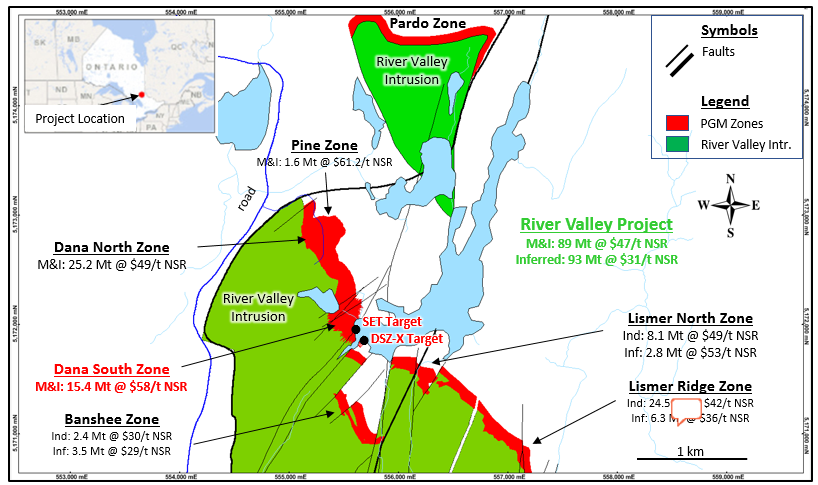
Dana South-Extension Drilling Results
Four drill holes totalling 1,133 m were completed at the Dana South-Extension Target (Table 1). These drill holes were designed to test for mineralization intersected in a 2021 geomechanical drill hole that intersected a thick interval of higher-grade mineralization outside the modelled boundary of Dana South mineralized (see NAM press release dated June 9, 2022). All four 2022 drill holes intersected Pd mineralization. Assay interval highlights are listed in Table 2.
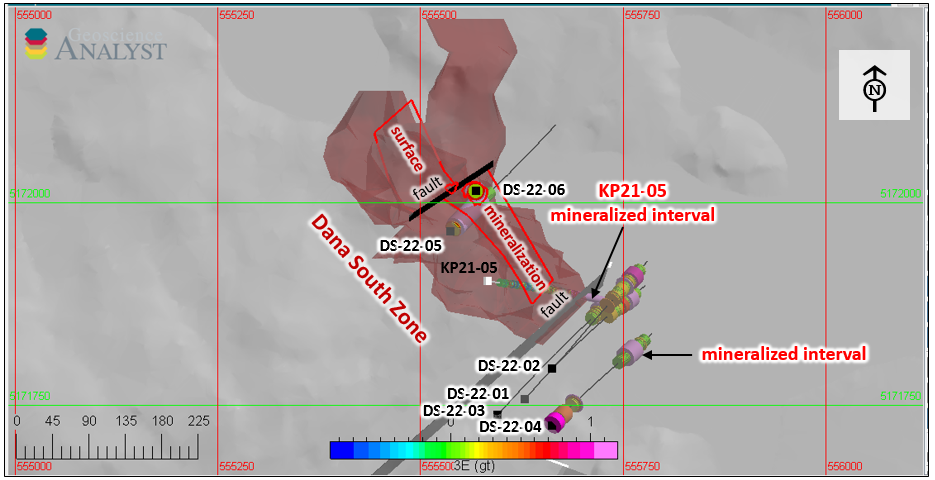
Drill holes DS-22-01 to DS-22-03 were completed on a step-out cross-section 50 m from the previously interpreted, faulted boundary of Dana South (Figure 2). Drill hole DS-22-01 tested the middle part of the section, returned four mineralized intersections, one of which is higher-grade than the average grade of the current Dana South Mineral Resources (Table 2). DS-22-02, drilled above DS-22-01, intersected 6.803 g/t 3E over 1 m from 197 m downhole. DS-22-03, the deepest hole on the section, returned the best results: 1.335 g/t 3E and 0.134 % Cu over 41 m from 258 m downhole, including 2.010 g/t 3E and 0.156% Cu over 15 m from 268 m downhole and 1.582 g/t 3E and 0.221% Cu over 9 m from 288 m downhole.
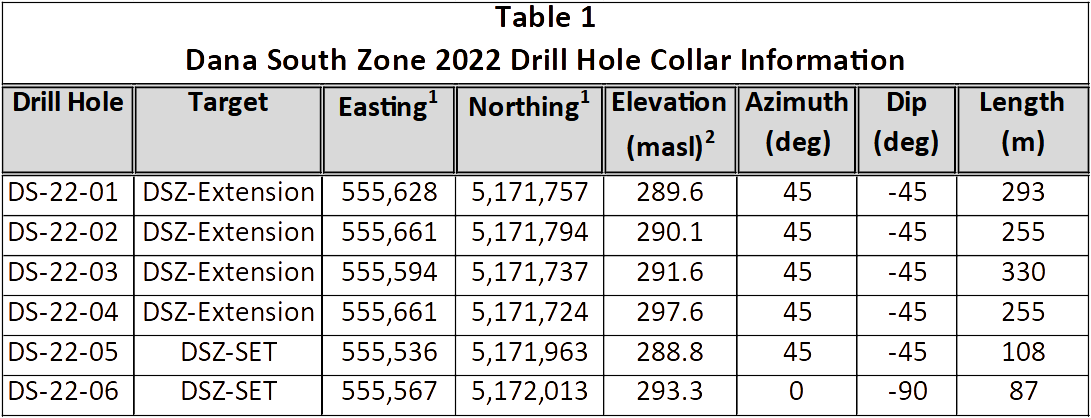
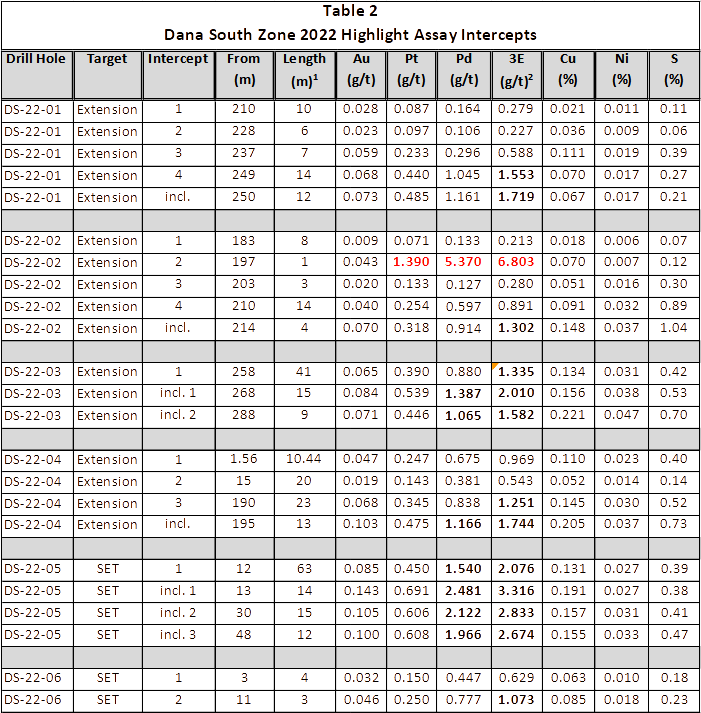
Drill hole DS-22-04, completed on an additional 50-m step-out, returned three mineralized intersections. The best of these intersections was 1.251 g/t 3E and 0.145% Cu over 23 m from 190 m downhole, including 1.744 g/t and 0.205% Cu over 13 m from 195 m downhole. In addition, DS-22-04 also intersected mineralization from surface; that is, 0.969 g/t 3E and 0.110% Cu over 10.4 m from bedrock surface (Figure 2). This shallower occurrence of mineralization is known from historical drilling, but the latter is currently too sparse for Mineral Resource estimation.
The above references an opinion and is for information purposes only. It is not intended to be investment advice. Seek a licensed professional for investment advice. The author is not an insider or shareholder of any of the companies mentioned above.
Fathom Nickel (CSE:FNI) has announced that the Gochager Lake Exploration Permit has been received, and field crews are mobilizing to begin the Q12023 exploration program at the project. The company will begin drilling on or around February 10 at the Gochager Lake Project, which is host to disseminated – massive sulphide nickel-copper-cobalt mineralization.
Fathom Nickel will employ borehole electromagnetic surveys to delineate the semi-massive to massive zones of nickel-copper-cobalt mineralization, which was first recognized at the property in the late 1960s.
Commenting on the Gochager Lake Project, Ian Fraser, CEO and VP of Exploration, commented in a press release: “The Gochager Lake Project is an important addition to the Company’s portfolio of “battery metal” projects. We look forward to applying BHEM in our effort to delineate zones of semi-massive to massive nickel-copper-cobalt mineralization within broader disseminated mineralization that defines the historic Gochager Lake deposit.”
The summary and highlights of the program are as follows:
- Receipt of exploration permit for the recently acquired Gochager Lake Project.
- Commencement of Q1 2023 exploration program at Gochager Lake and Albert Lake Projects.
- Drilling to start around February 10, 2023 at Gochager Lake; results expected by mid April.
- Historic Drillhole at Gochager had a 294-meter intercept that returned 0.58% Ni, 0.11% Cu starting immediately below surface; within this interval was a 9.70-meter section that assayed 2.37% Ni, 0.35% Cu and 0.14% Co.
- Gravity survey initiated at the Tremblay Olson Claims area (Albert Lake) with drilling to start around 4th week of February.
The Gochager Lake Property and Q1-2023 Drill, BHEM Program
The Gochager Lake Property comprises nine mineral dispositions totalling 4,696 hectares located in north-central Saskatchewan, approximately 75 km north of the town of La Ronge and in close proximity to the Company’s flagship Albert Lake Project (Figure 2). Within the historic Gochager Lake deposit1, diamond drillhole I-12 drilled in 1967 had a 290.4-meter intercept that returned 0.58% Ni, 0.11% Cu starting immediately below surface. Within this interval, and at the base of this interval, a 9.70-meter section assayed 2.37% Ni, 0.35% Cu and 0.14% Co. In 2018, drillhole GL18-001 intersected semi-massive to massive, magmatic nickel sulphide mineralization (Figure 1) within the vicinity of historic drillhole I-12 demonstrating this style of mineralization exists within the historic deposit and that it does contain significant nickel-copper-cobalt mineralization.

The Company intends to drill a hole in close proximity to historic drillhole I-12 primarily for the purpose of providing a BHEM platform to test for continuation and orientation of semi-massive to massive nickel-copper-cobalt lenses. These lenses are expected to be contained within the broader disseminated mineralization that defines the historic Gochager Lake deposit. In addition, and for the first time in the property’s history, the drillhole will be systematically sampled for cobalt. Previous operators only sporadically sampled for cobalt. As a result, the amount of cobalt associated with the known nickel-copper mineralization is not well understood. A second drillhole will be drilled for the purpose of better defining lithology and mineralization controls. This drillhole will be drilled approximately 25 meters along strike of the I-12 location and the dip and azimuth will be designed to be perpendicular to the interpreted trend of the Gochager Lake deposit. This drillhole will also be probed by the BHEM tool. The Company is also optimistic that the two drillholes drilled in 2018 will also provide platforms for additional BHEM surveys. Drillhole results from the program will be released once received and interpreted by the Company. Pending actual timing for the receipt of assays from our lab, we anticipate releasing the results in late March – early April.
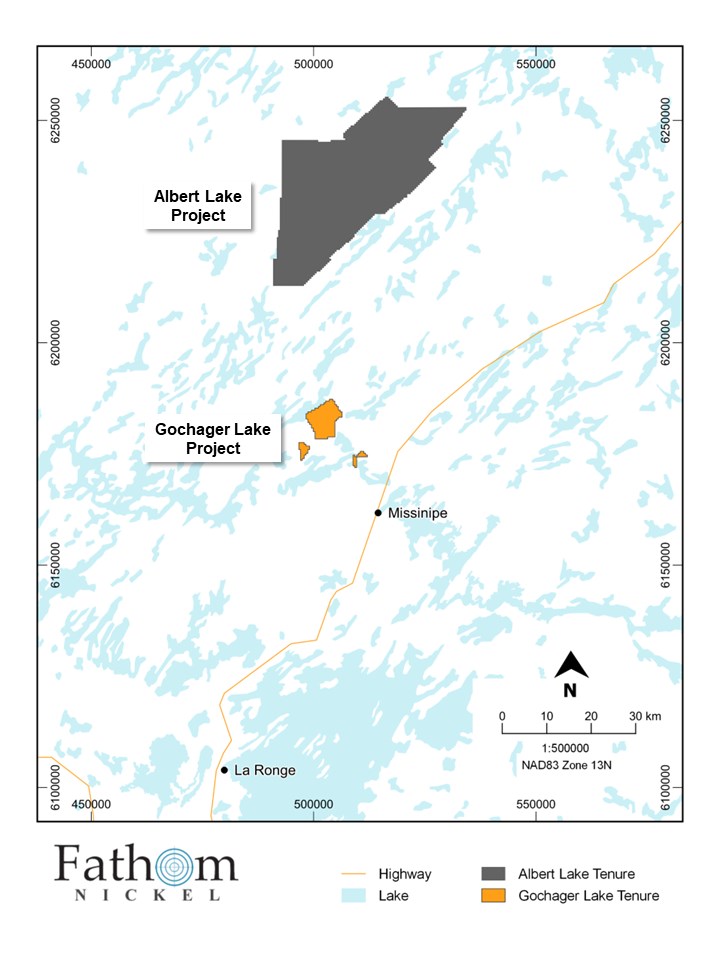
The Albert Lake Property and Q1-2023 Exploration Program
Exploration at Albert Lake has also commenced. A crew was mobilized to site over the weekend of February 3-5 to initiate gravity survey coverage over the Tremblay-Olson Claims area. Fathom conducted a gravity survey in 2021 in the historic Rottenstone Mine area and this survey proved instrumental in defining the structural corridor that is host to The Bay Island Trend.
The gravity survey will tie into the existing gravity stations and is expected to take up to 10 days to complete. Results of this survey will be utilized, along with other geophysical models the Company has been developing, to target drill locations within the Tremblay-Olson Claims area. The Company anticipates issuing details on the planned Albert Lake program prior to commencement of drilling which is expected to begin in the 4th week of February.
The above references an opinion and is for information purposes only. It is not intended to be investment advice. Seek a licensed professional for investment advice. The author is not an insider or shareholder of any of the companies mentioned above.
Snowline Gold (CSE:SGD) has announced new preliminary assay results from the 2022 drilling program at the Valley Zone, Rogue Project in Yukon. Most notably, the company intersected a zone of sheeted quartz from surface at hole V-22-028, including zones of 2.03 g/t Au over 129.9 m and 2.15 g/t Au over 42.3 m and further mineralization found at depth. The hole was collared 121 m from the nearest hole (V-22-014; 285.2 m @ 1.45 g/t Au) and drilled northeast, demonstrating continuity of mineralization within Valley’s near-surface mineralized corridor. Currently, assays are pending for 3,474m of the 2022 Rogue drill program, representing 26% of the total program.
Scott Berdahl, CEO & Director of Snowline, commented in a press release: “We are continually impressed not only by the scale but by the continuity of gold mineralization at Valley. Today’s results build on earlier holes, with V-22-028 adding significant tonnage with strong gold grades. The hole demonstrates a wide breadth to the mineralized zone and grade continuity between previous holes. In addition, promising mineralization seen in V-22-019 shows potential for the near-surface higher grades to continue to the southeast, while V-22-020 shows widespread mineralization within the Valley intrusion beyond the main gold zones known to us at present. We look forward to receiving additional assays from the 2022 season as we gear up for an exciting exploration program in 2023.”

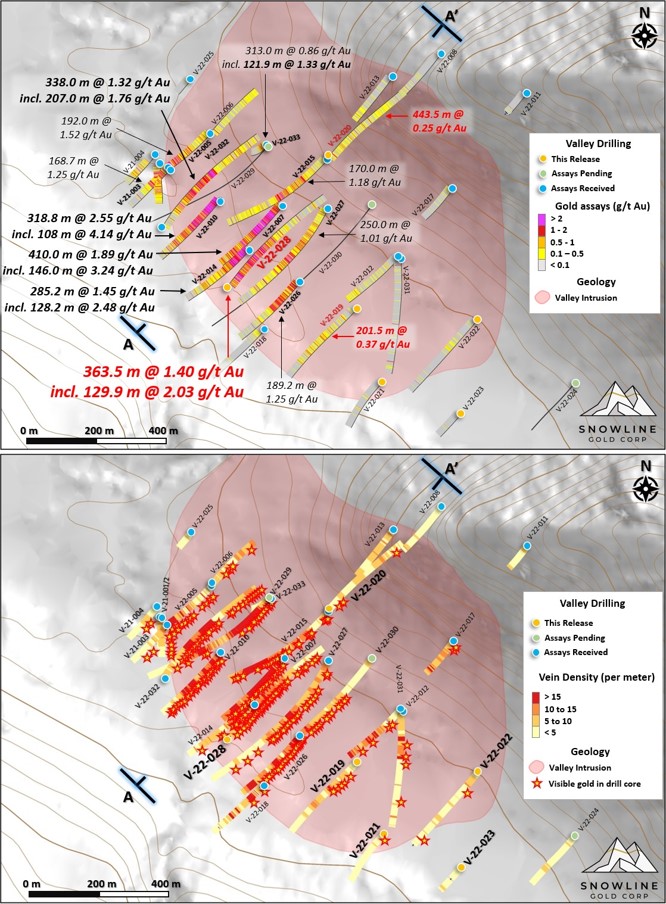
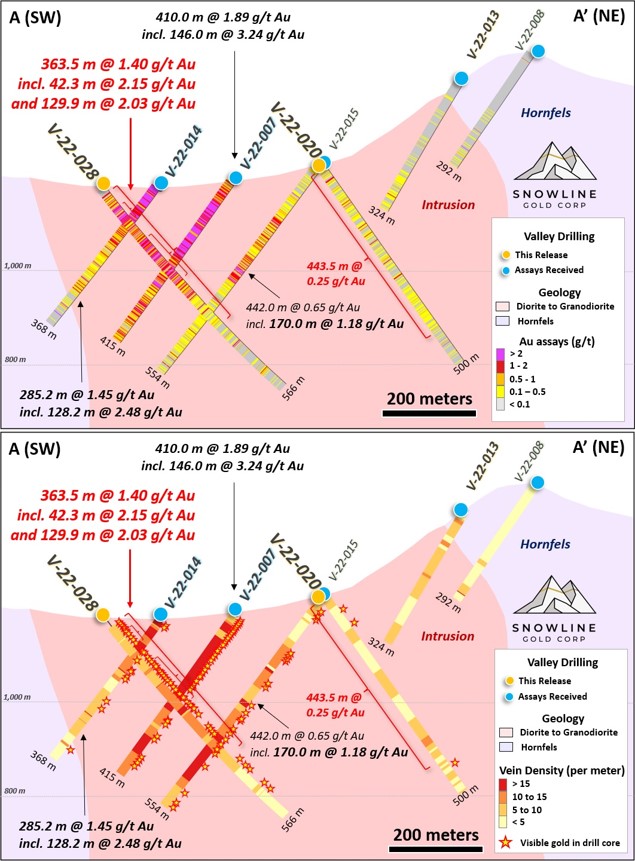
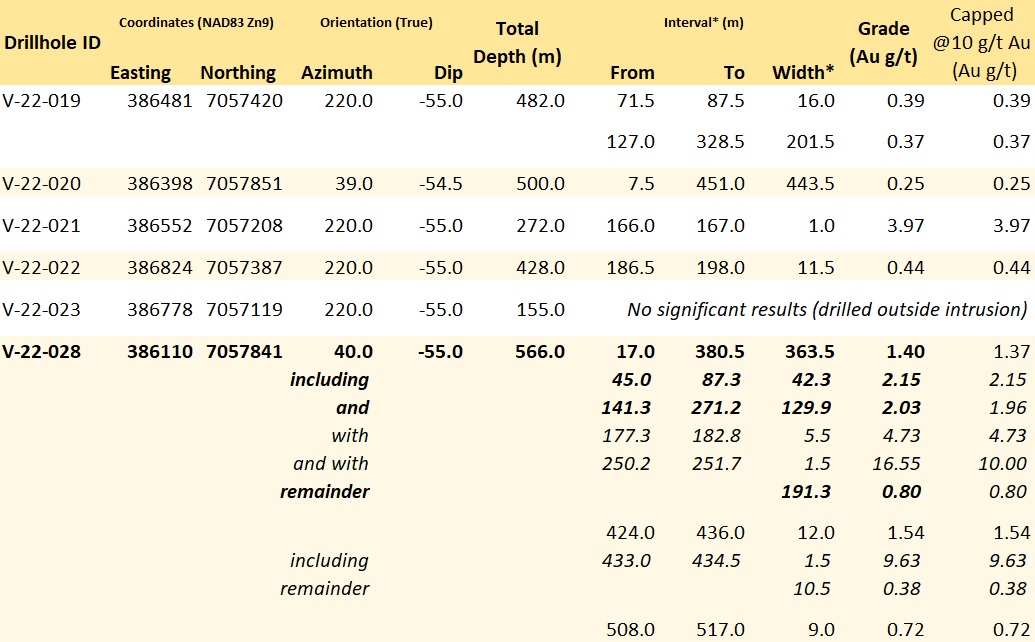
Highlights from the results are as follows:
- Hole V-22-028 returned 1.40 g/t Au over 363.5 m from surface, including 2.03 g/t Au over 129.9 m and 2.15 g/t Au over 42.3 m from its Valley Zone
- Additional results extend known strike length of potentially economic gold grades along mineralized corridor to 720 m (open) and delineate gold-bearing quartz vein arrays along relatively underexplored eastern boundary of the Valley intrusion
- Assays still pending for 7 of 32 holes (3,474 m, or 26% of 13,320 m) drilled at Valley and Gracie in 2022.
HOLE V-22-028
Hole V-22-028 was collared near the western margin of the Valley intrusion, 121 m from the collar site for V-22-014 (285.2 m @ 1.45 g/t Au including 128.2 m @ 2.48 g/t Au, see Snowline news release dated November 15, 2022), and drilled towards the northeast into the intrusion. The hole encountered abundant sheeted quartz veins with trace visible gold, returning 1.40 g/t Au over 363.5 m from bedrock surface at approximately 17.0 m depth, including higher grade intervals of 2.15 g/t Au over 42.3 m from 45.0 m and 2.03 g/t Au over 129.9 m from 141.3 m.
The hole extends the known width of near-surface, >1 gram per tonne gold mineralization at Valley, and demonstrates continuity of mineralization between previous holes V-22-014 and V-22-007 (410.0 m @ 1.89 g/t Au including 146.0 m @ 3.24 g/t Au, see Snowline news release dated November 15, 2022) along the western edge of the highest-grade zone of the Valley gold system encountered to date.
As with previous holes at Valley, gold grades are carried across broad intervals, and they are not heavily affected by local high-grade (>10 g/t Au) intersections (Table 2).
HOLE V-22-019
Hole V-22-019 was collared in the Valley intrusion as a step-out along strike of the well-mineralized corridor, roughly 178 m from previous hole V-22-026 (289.7 m @ 0.90 g/t Au including 189.2 m @ 1.25 g/t Au, see Snowline news release dated January 18, 2023). The hole encountered widespread low to moderate density of quartz veins hosting gold mineralization, with five instances of trace visible gold noted during logging. Two primary mineralized intervals returned 0.39 g/t Au over 16.0 m from 71.5 m downhole and 0.37 g/t Au over 201.5 m from 127.0 m downhole, extending the northwest-southeast strike length of potentially economic grades at Valley to 720 m. The system remains open. Given the depth of the observed intervals and the tendency elsewhere along the trend for higher grades near surface, the ground above and around this intersection is considered by the company to be highly prospective. Drilling planned for 2023 will test shallower parts of this area.
From bedrock surface at 19.9 m downhole depth to the bottom of consistent mineralization at 390.1 m downhole depth, including barren intervals within, V-22-019 averaged 0.29 g/t Au over 370.2 m.
HOLE V-22-020
Hole V-22-020 was collared in the Valley intrusion at the pad site of V-22-015 (442.0 m @ 0.65 g/t Au including 170.0 m @ 1.18 g/t Au, see Snowline news release dated December 22, 2022), but drilled at the opposite azimuth, towards the northeast. The hole encountered a low to moderate density of quartz veins dipping to the northeast, generally at low angles to the core axis. The top 443.5 m of the hole averaged 0.25 g/t Au from bedrock surface at 7.5 m, with generally consistent gold mineralization. As with previous hole V-22-006 (Figure 1), zones of increased grade continuity occur towards the northeastern margin of the Valley intrusion, suggesting the possibility of additional grade-controlling features in this lightly explored part of the system. The hole did not exit the intrusion by its end at 500 m downhole depth.
The above references an opinion and is for information purposes only. It is not intended to be investment advice. Seek a licensed professional for investment advice. The author is not an insider or shareholder of any of the companies mentioned above.
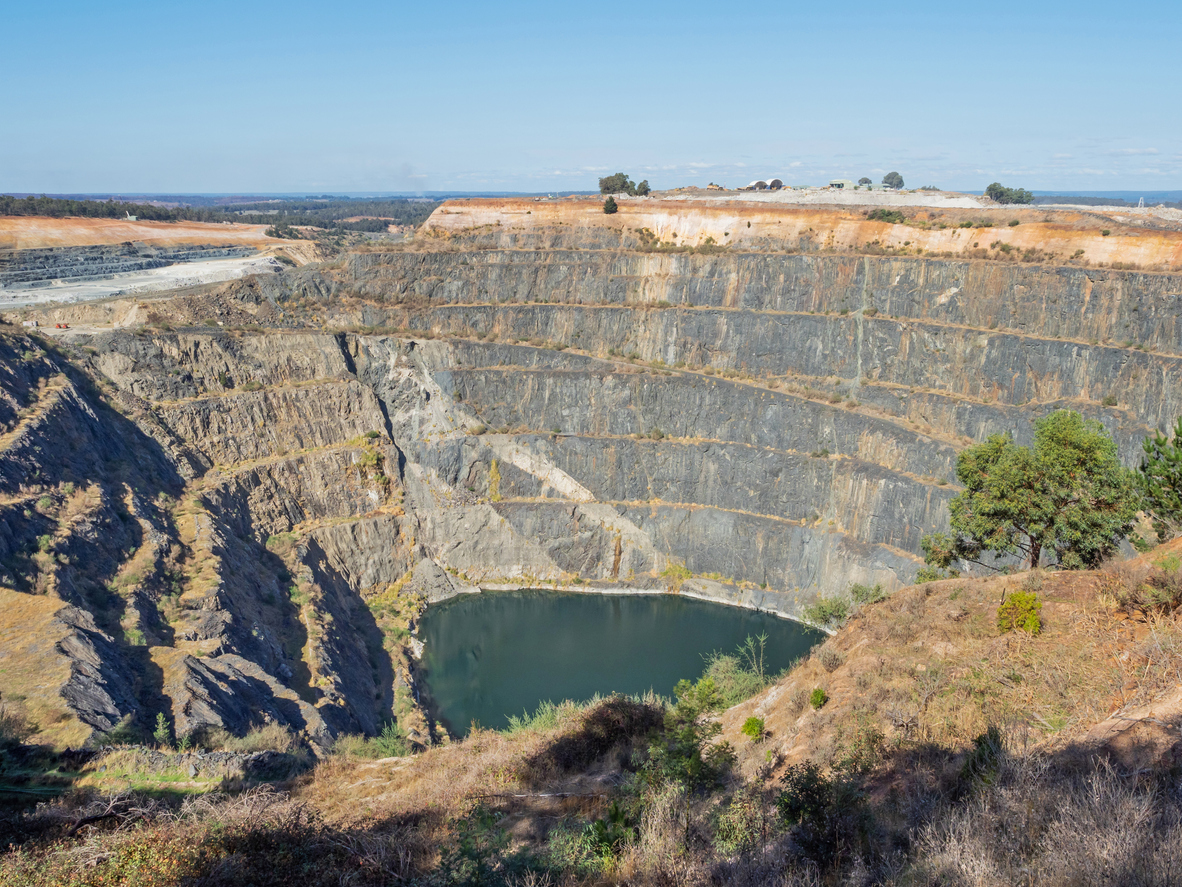
Sprott Asset Management LP has announced that four new critical mineral ETFs will be launched, giving investors exposure to critical minerals essential to the storage, transmission, and generation of clean energy. The company is a wholly-owned subsidiary of Sprott inc.
The four funds are as follows, and will track induced that the company developed with Nasdaq, which will list the ETFs on its exchange:
- Sprott Energy Transition Materials ETF (Nasdaq: SETM)
- Sprott Lithium Miners ETF (Nasdaq: LITP)
- Sprott Junior Uranium Miners ETF (Nasdaq: URNJ)
- Sprott Junior Copper Miners ETF (Nasdaq: COPJ)
The funds join the Sprott Uranium Miners ETF (NYSE Arca: URNM), and Sprott Physical uranium Trust (TSX:U.U, U.UN) under the energy transition fund suite.
Countries around the world are creating new incentives and investing at rates never seen before to fund the transition to clean energy. This shift is creating demand for critical minerals and metals. These materials are needed not only to produce the components of renewable energy, but also to upgrade and maintain existing infrastructure.
By investing in these ETFs, investors can gain exposure to the companies that are engaged in the production, exploration, and development of critical minerals and metals needed to support a transition to clean energy.
Sprott’s ETFs were the first of their kind to offer investors a targeted exposure to the critical minerals and metals required for the energy transition. The funds will provide investors with access to the companies that are actively engaged in the production, exploration, and development of these resources, enabling them to capitalize on the growth opportunity created by the shift to clean energy.
Summary of new Sprott ETFs
SETM seeks to provide investment results that correspond generally to the total return performance of the Nasdaq Sprott Energy Transition Materials Index, which is designed to track the performance of a selection of global securities in the energy transition materials industry.
LITP aims to provide investment results that correspond generally to the total return performance of the Nasdaq Sprott Lithium Miners Index, which is designed to track the performance of a selection of global securities in the lithium industry, including lithium producers, developers and explorers.
The aim of URNJ is to provide investment results that correspond generally to the total return performance of the Nasdaq Sprott Junior Uranium Miners Index, which is designed to track the performance of mid-, small- and micro-cap companies in uranium mining-related businesses.
COPJ seeks to provide investment results that correspond generally to the total return performance of the Nasdaq Sprott Junior Copper Miners Index, which is designed to track the performance of mid-, small- and micro-cap companies in copper mining-related businesses.
The above references an opinion and is for information purposes only. It is not intended to be investment advice. Seek a licensed professional for investment advice. The author is not an insider or shareholder of any of the companies mentioned above.
Timberline Resources (TSXV:TBR) has announced it has discovered a new high-grade gold and silver target in the New York Canyon claim block of the 100%-controlled Eureka Project in Nevada has been discovered. The company completed mapping and sampling in the historical mining area, and identified the new drill target with outcropping high-grade gold and silver mineralization. The company will now focus on follow-up drilling and exploration to prioritize a cluster of high-grade rock chip samples around the historical Eureka Giant, Seventy-Six, and Eureka Mines. Results at these mines returned high gold values of 55, 32, 23.3, 22.5, and 14.95 g/t, along with numerous other samples in the 0.5 to 5.0 g/t range, and high silver values of 750*, 582.5, 558, 555, and 299 g/t, along with many other samples exceeding 50 g/t silver.
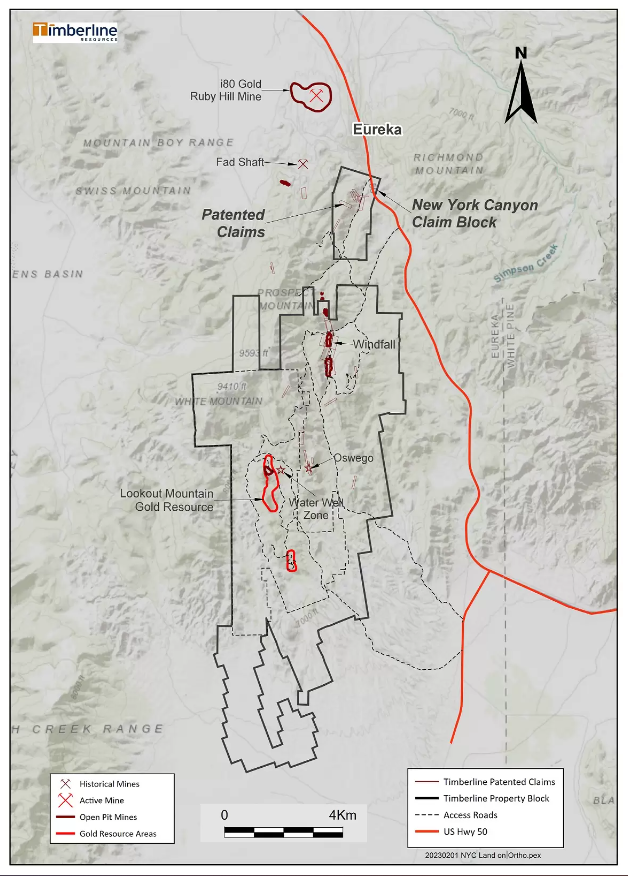
Patrick Highsmith, Timberline’s President and CEO commented in a press release: “The patented mining claims in New York Canyon were among the very first claims staked in the Eureka District in the 1860s. The outcropping high-grade silver and gold target has been unavailable for modern exploration due to the fragmented claim ownership. Now that we have consolidated and control these claims, we plan to drill these targets. Our recent sampling confirms historical data in the area reflecting high-grade CRD-type silver-lead-zinc mineralization and overprinting Carlin-type gold hosted in the Hanson Creek formation. The alteration is intense along large northwest trending faults, and significant potential exists for larger volumes of mineralization in the underlying Ordovician rocks that are important hosts to mineralization at the Ruby Hill Mine.”
Highlights from the results are as follows:
The New York Canyon target area is in the heart of the historical Eureka mining district, which was noted for its carbonate-replacement deposits (CRD) of silver, lead, and zinc before large-scale gold mineralization was known in the area. I80 Gold Corp. is actively drilling high-grade CRD-type silver-rich mineralization at the nearby Ruby Hill Mine (approximately 3km northwest), and Paycore Minerals has recently reported deep intercepts of silver and gold-rich CRD mineralization at the Fad Shaft (approximately 2km west-northwest).
Table 1 – Selected high-grade rock samples from New York Canyon target area
| Sample ID | Au (g/t) | Ag (g/t) | Pb (%) | Zn (%) | Cu (%) | Company |
| 8150A | 55.00 | 246 | 0.76 | 0.57 | 0.29 | Timberline |
| 8251 | 32.00 | 555 | 0.60 | 0.48 | 0.26 | Timberline |
| 8173 | 22.50 | 178 | 0.49 | 0.31 | 0.14 | Timberline |
| 8255 | 23.3 | 558 | 0.94 | 0.65 | 0.33 | Timberline |
| 8150B | 14.95 | 251 | 0.50 | 0.25 | 0.15 | Timberline |
| 667_NY | 0.09 | 750 | 0.43 | n/a | n/a | Historical* |
| 8306 | 0.497 | 583 | 0.14 | 0.07 | 0.44 | Timberline |
| 8253 | 1.93 | 299 | 0.68 | 0.57 | 0.35 | Timberline |
| 8174 | 0.21 | 157 | 0.12 | 8.40 | 0.83 | Timberline |
| 8315 | 0.53 | n/a | 7.16 | 0.38 | n/a | Timberline |
| 8264 | 0.56 | 145 | 5.17 | 0.02 | 0.03 | Timberline |
| * – See Notes on Disclosure of Historical Estimates Below | ||||||
The New York Canyon target lies near the northern end of Timberline’s 70 km2 Eureka project, and where prospectors staked some of the first claims in the district in the 1860s. The early miners pursued the high grades of silver, lead, and zinc (with gold credits) associated with the CRD’s. Exploration companies returned to the area in the 1980s and 1990s, evidenced by the rock samples and drillholes shown on Figure 2 and Figure 3, but the patented claims over this particular target restricted access during that period. Timberline now controls the patented claims at New York Canyon and plans to aggressively explore the high-grade, gold-silver bearing structures during 2023.
The above references an opinion and is for information purposes only. It is not intended to be investment advice. Seek a licensed professional for investment advice. The author is not an insider or shareholder of any of the companies mentioned above.
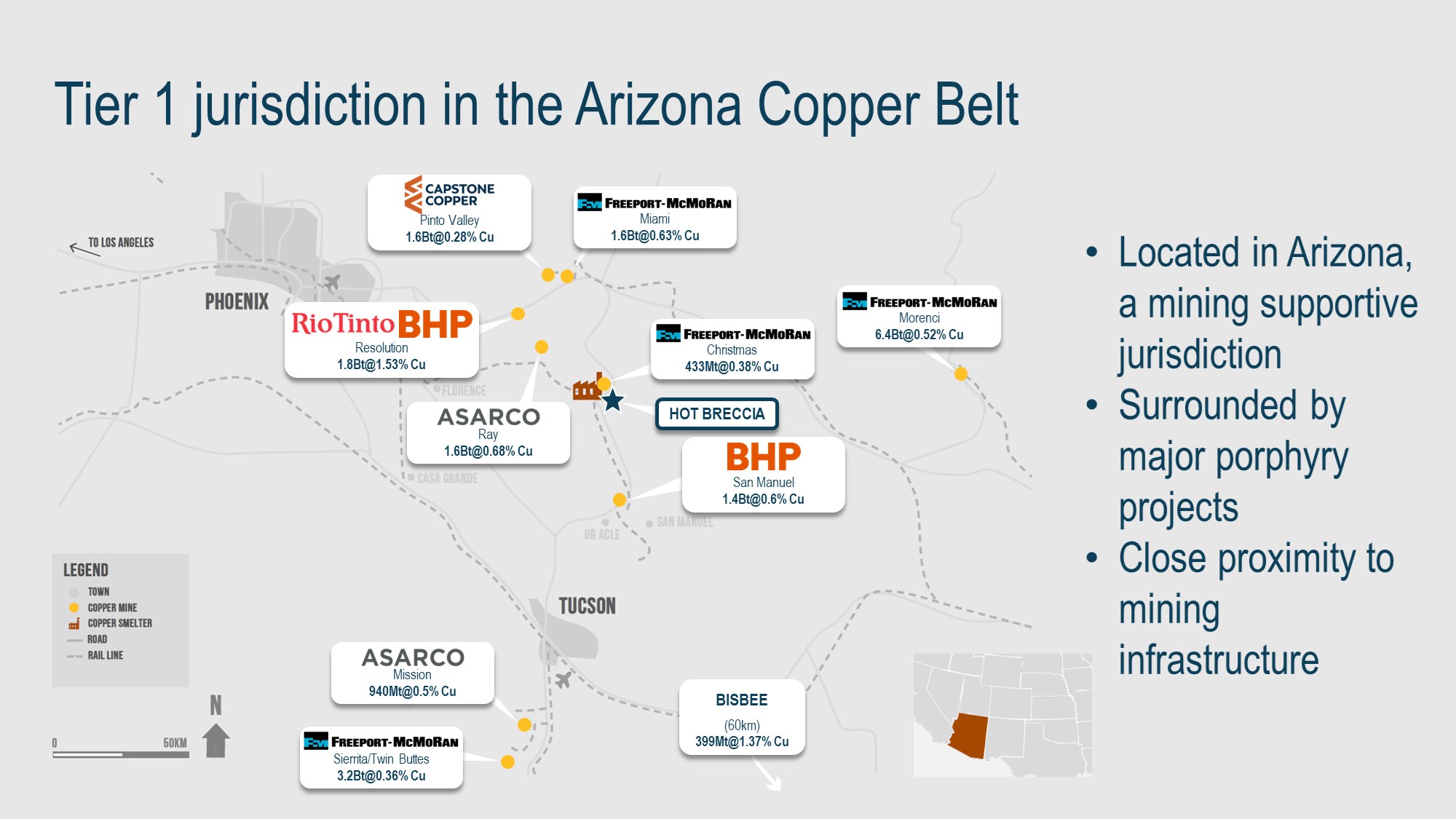
Prismo Metals (CSE:PRIZ) has announced that a definitive agreement has been signed with Infinitum Copper (TSXV:INFI) for Prismo to acquire 75% of the Hot Breccia porphyry copper-skarn project in the Arizona Copper Belt. Hot Breccia includes 227 mining concessions located roughly four kilometres from the historic Christmas mine.
The company believes that the Hot Breccia property could contain high-grade skarn mineralization that is similar to the mineralization mined at the Christmas mine. It is using the historical information which recorded production of roughly 481.6 Mlbs of copper from 20.2 M tons at a grade of 1.2% Cu plus significant gold and silver to only guide and plan for future exploration.
To acquire the 75% interest in the Hot Breccia property, Prismo will pay $350,000 in cash and issue 500,000 common shares of Prismo Metals to Infinitum Copper. It will also assume some earn-in obligations of Infinitum under the Option Agreement with Walnut Mines.
Hot Breccia is already subject to an Option Agreement between Walnut Mines and Infinitum. Walnut Mines has provided data from drill holes completed by Bear Creek Mining, which is a subsidiary of Kennecott Copper Co., on a portion of the property back in the 1970s and 1980s. Several high-grade mineralization intercepts were reported, although that data is not NI 43-101 compliant.
Once the earn-in obligations have been satisfied and the option is exercised, Prismo and Infinitum will enter a new joint venture agreement where Prismo will become the initial operator of the project. At that point, the company will have acquired 75% of the property and will be subject to a 2% NSR royalty to Walnut Mines.
Dr. Gibson, President and CEO of Prismo, commented in a press release: “This acquisition agreement gives Prismo exposure to a copper system in the world-class Arizona copper belt with possible precious metal values. We anticipate beginning exploration work at the project quickly and expect to be drilling before the end of the year. Prismo has enough cash on hand to meet property payments and minimum exploration expenditures on all its projects, including Hot Breccia, through 2024.”
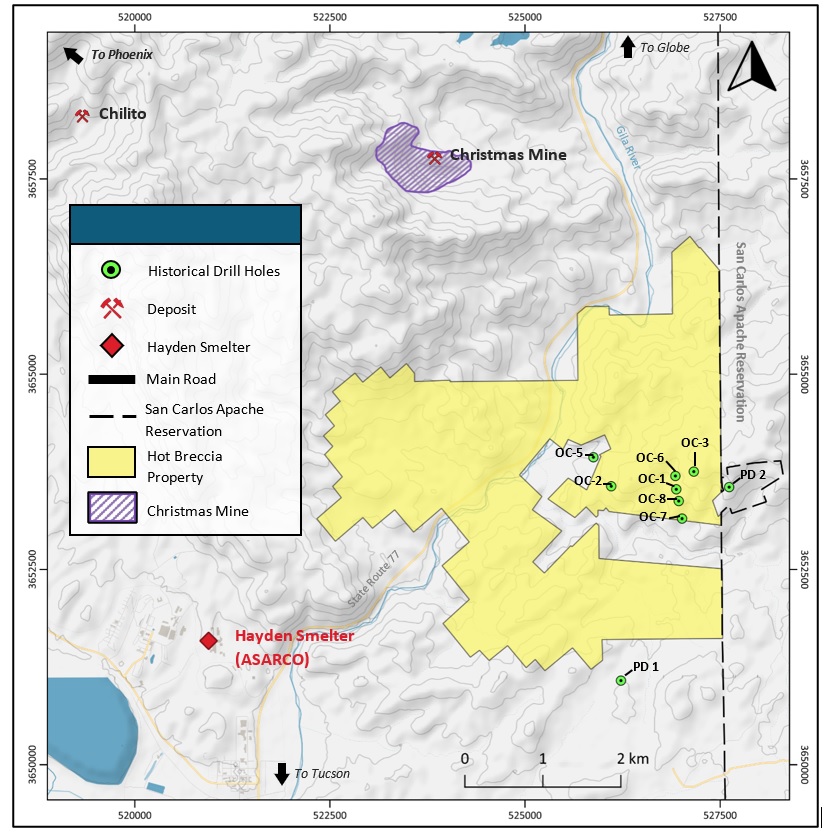
Earn-In Obligations to Walnut:
| As at | Work Commitments | Property Payments | Share Payments |
| January 31 | To be satisfied by Prismo | To be made by Prismo | To be made by Infinitum |
| 2024 | $500,000 | $165,000 | 250,000 shares |
| 2025 | $1,000,000 | $100,000 | 500,000 shares |
| 2026 | $1,750,000 | $275,000 | 875,000 shares |
| 2027 | $2,000,000 | – | 750,000 shares |
| Total | $5,250,000 | $540,000 | 2,375,000 shares |
Drill hole data for holes from the Kennecott program
| Hole | Easting | Northing | Elev. (ft) | Azim | Incl | Depth (ft) | |
| OC-1 | 526,901 | 3,653,535 | Unknown | Vert | – | 2406 | |
| OC-2 | 526,090 | 3,653,577 | Unknown | Vert | – | +970? | |
| OC-3 | 527,117 | 3,653,763 | Unknown | Vert | – | +970? | |
| UnknownOC-5 | 525,869 | 3,653,946 | Unknown | Vert | – | +500? | |
| OCC-6 | 526,890 | 3,653,709 | 2,520 | Vert | – | 3,704 | |
| OCC-7 | 527,078 | 3,653,356 | 2,500 | Vert | – | 3,587 | |
| OCC-8 | 526,957 | 3,653,368 | 2,500 | Vert | – | 2,908 | |
Coordinates in UTM NAD27 estimated from drill logs.
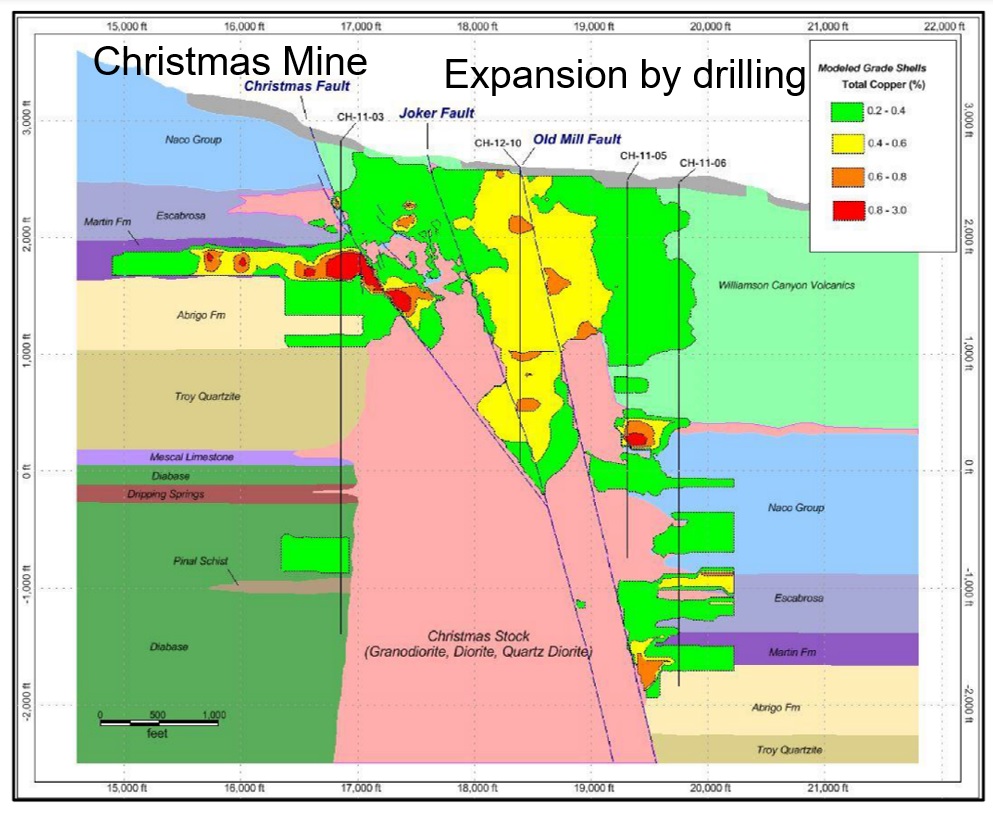
The above references an opinion and is for information purposes only. It is not intended to be investment advice. Seek a licensed professional for investment advice. The author is not an insider or shareholder of any of the companies mentioned above.
If you would like to receive our free newsletter via email, simply enter your email address below & click subscribe.
CONNECT WITH US
Tweets
Tweet with hash tag #miningfeeds or @miningfeeds and your tweets will be displayed across this site.
MOST ACTIVE MINING STOCKS
Daily Gainers
 Lincoln Minerals Limited Lincoln Minerals Limited |
LML.AX | +125.00% |
      |
GCR.AX | +33.33% |
      |
CASA.V | +30.00% |
      |
AHN.AX | +22.22% |
      |
ADD.AX | +22.22% |
      |
AZM.V | +21.98% |
      |
NSE.V | +21.05% |
      |
DYG.V | +18.42% |
      |
AAZ.V | +18.18% |
      |
GLA.AX | +17.65% |

 Follow us on Twitter
Follow us on Twitter Become our facebook fan
Become our facebook fan








